Oak trees are among the most iconic and diverse trees found across the Northern Hemisphere. From towering giants in dense forests to hardy species thriving in dry, rocky soils, oaks have adapted to a wide range of climates and conditions. With their signature lobed leaves and acorns, they play a vital role in supporting wildlife, stabilizing ecosystems, and enhancing landscapes with their beauty and resilience.
There are many types of oak trees, each with unique features that help with identification. Some are evergreen, keeping their leaves year-round, while others are deciduous, putting on vibrant autumn displays. From the classic White Oak to the rare Hinckley Oak, each species differs in leaf shape, bark texture, acorn size, and growth habit.
In this guide, we’ll explore 58 common types of oak trees with detailed descriptions and identification tips. You’ll learn about their native regions, growth habits, leaf characteristics, and USDA hardiness zones. We’ll also include pictures to help you visually distinguish each species, making it easier to identify oaks in the wild or in your own backyard.
North American Oaks
Northern Red Oak (Quercus rubra)
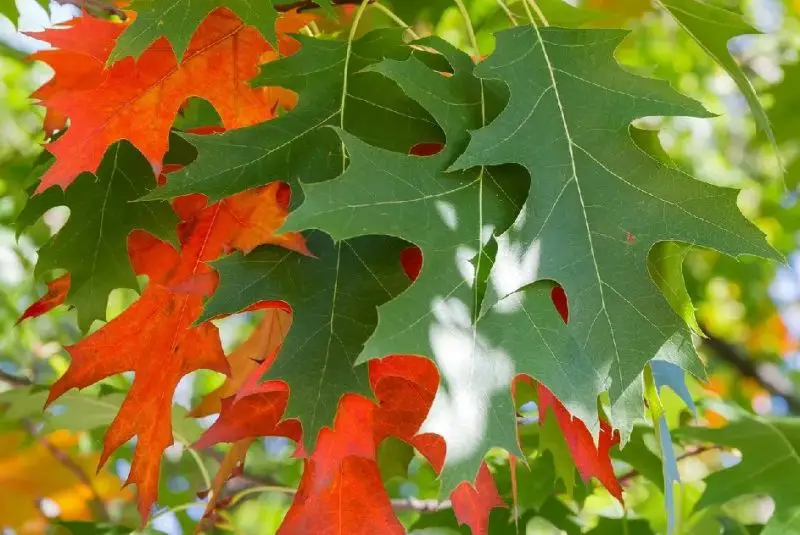
Northern Red Oak is a prominent deciduous tree native to eastern and central North America. It is admired for its strong, upright growth habit and stately presence, often reaching 60 to 75 feet tall with a straight trunk and wide-spreading, rounded crown. Its bark is dark gray to nearly black and develops shiny vertical ridges on younger trees, which become rougher and more furrowed with age. This species is widely planted in urban areas and parks due to its adaptability and rapid growth.
The leaves are one of its defining features, typically 5 to 9 inches long with 7 to 11 sharply pointed lobes tipped with tiny bristles. During the growing season, they appear deep green and glossy on the upper surface and duller underneath. In autumn, they turn brilliant shades of red to scarlet, making the tree particularly eye-catching. The acorns are round and relatively large, about 1 inch long, with a flat, saucer-like cap that covers only the base.
Northern Red Oak grows best in USDA hardiness zones 4 through 8. It prefers full sun and well-drained, slightly acidic loamy soils but is tolerant of a range of conditions, including urban pollution. While generally low-maintenance, it benefits from deep watering during prolonged droughts and periodic pruning to remove dead or crossing branches. Mulching around the base helps retain soil moisture and suppress weeds.
Southern Red Oak (Quercus falcata)

Southern Red Oak is a tall, elegant species native to the southeastern United States. It commonly reaches heights of 70 to 80 feet, with a spreading crown and a strong central trunk that provides structural beauty in landscapes. It naturally thrives in upland areas, especially on dry ridges and sandy soils, and is well-adapted to heat and drought. The bark is dark gray to black, rough-textured, and becomes deeply furrowed as the tree matures.
This species is best identified by its distinctive leaves, which are often variable but generally feature 3 to 5 deeply cut lobes. The terminal lobe tends to be longer and curves to one side, giving the leaf a sickle-like appearance. The upper leaf surface is shiny and dark green, while the underside is paler with soft hairs. Acorns are small, about ½ inch long, with shallow caps, and they usually mature in the fall of their second year.
Southern Red Oak is suitable for USDA zones 6 to 9. It performs best in full sun and well-drained, slightly acidic soils, particularly in areas with dry summers. This oak is known for its durability and resilience in poor, sandy, or rocky soil conditions, making it an excellent choice for naturalized plantings or large-scale reforestation. Minimal care is needed beyond initial watering during establishment and occasional trimming to maintain shape and structure.
Black Oak (Quercus velutina)
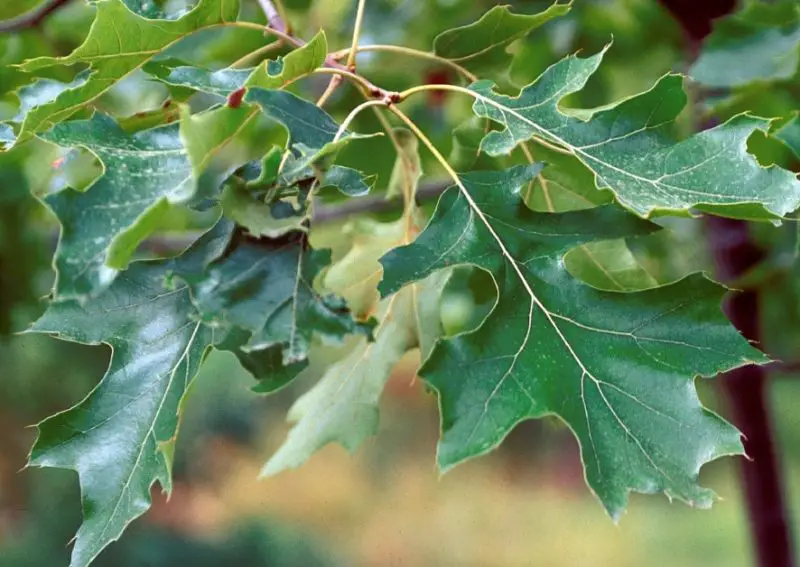
Black Oak is a robust, deciduous tree native to a broad range of eastern and central North America. Typically growing between 50 and 80 feet in height, it features a relatively irregular crown and a thick, dark trunk. The bark is almost black and deeply furrowed, often separating into rough plates, while the inner bark is a vibrant orange-yellow and historically used to produce dye and tannins. The tree’s rugged appearance and rich fall colors make it a favorite in natural landscapes.
Leaves are 4 to 8 inches long, with 5 to 7 deeply cut lobes, each ending in a bristle tip. They are glossy dark green above and paler, often slightly fuzzy, beneath. In the autumn months, the foliage takes on a striking mix of red, yellow, and bronze hues. The acorns are large and mature in two seasons, with a deep cup-shaped cap that encloses about half of the nut. The tree often retains its dried leaves into early winter.
Black Oak grows in USDA zones 4 through 9 and prefers full sun with well-drained, acidic to slightly acidic soils. It tolerates dry, rocky uplands and is commonly found on slopes or ridges. Care should be taken during transplanting, as the tree has a sensitive root system. Watering deeply during dry periods, mulching, and pruning in the dormant season can help maintain its long-term health and vigor.
Pin Oak (Quercus palustris)

Pin Oak is a fast-growing and highly symmetrical oak species native to the central and eastern United States. It typically reaches 60 to 70 feet tall, although some specimens may grow taller under ideal conditions. The tree features a pyramidal crown with a strong central leader, and lower branches often angle downward, a key identifying trait. Its name comes from the small, pin-like twigs on its lower branches.
The leaves of Pin Oak are deeply lobed with 5 to 7 sharply pointed lobes and wide sinuses that nearly reach the midrib. Each lobe ends in a bristle, giving the leaf a delicate, lacy appearance. In summer, the leaves are glossy green, and in fall they transform into brilliant shades of red and bronze. The tree produces small acorns that are almost spherical, with thin, saucer-like caps that sit atop the nut.
This oak thrives in USDA hardiness zones 4 to 8 and prefers moist, acidic soils such as those found in bottomlands or along streams. While it is tolerant of poorly drained soils, it struggles in alkaline conditions, which can lead to chlorosis. Pin Oak grows best in full sun and benefits from consistent moisture during its early years. Pruning should be done in late fall or winter to reduce the risk of bleeding sap.
Scarlet Oak (Quercus coccinea)

Scarlet Oak is a beautiful and moderately fast-growing tree valued for its stunning autumn coloration. Native to the eastern United States, it grows to about 60 to 80 feet tall with a rounded, open canopy. The bark is smooth and gray when young, becoming ridged and darker with age. This oak is often found in dry uplands, slopes, and ridges, where it thrives in well-drained, sandy, or rocky soils.
The leaves are 4 to 7 inches long and typically have 7 pointed lobes with deep sinuses and bristle-tipped ends. They are glossy green during the growing season, turning fiery shades of scarlet, crimson, and red-orange in the fall—making it one of the showiest oaks in autumn. The acorns are relatively large and have bowl-shaped caps that cover about one-third of the nut, taking two seasons to mature.
Scarlet Oak grows best in USDA zones 4 through 9 and prefers full sun and well-drained, acidic soil. It is drought-tolerant once established and is often used in dry landscapes, hillsides, and naturalized areas. Minimal care is needed, though occasional deep watering and pruning during dormancy can improve structure and health. This tree also offers excellent wildlife value, supporting a variety of birds and mammals that feed on its acorns.
Shumard Oak (Quercus shumardii)
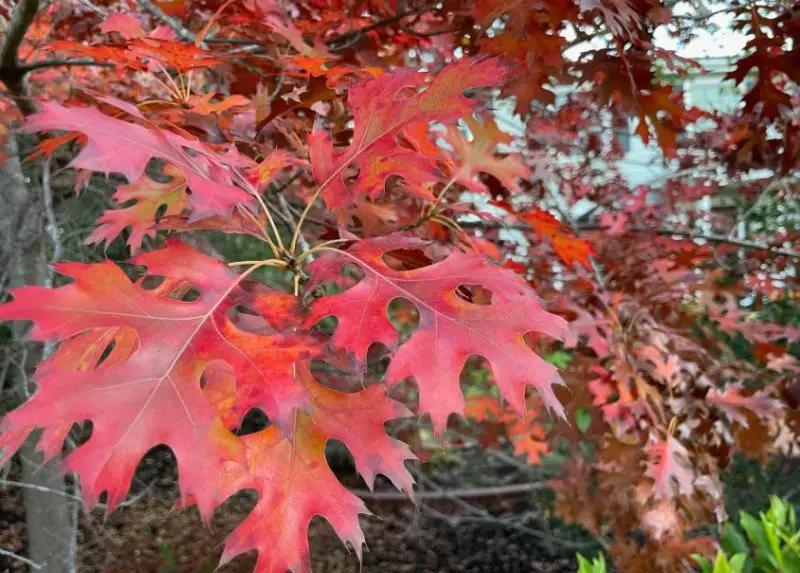
Shumard Oak is a large, stately tree native to the southeastern and south-central United States. It typically grows between 60 and 90 feet tall and develops a broad, open crown with strong horizontal branches. The bark is gray to dark brown, ridged, and furrowed with age. Shumard Oak is prized for its adaptability and is often used as a shade tree in parks, campuses, and large residential properties.
The leaves are deeply lobed with 7 to 9 pointed lobes that end in bristle tips. They are shiny dark green on top and paler underneath, often turning vibrant shades of red, orange, or russet in autumn. The acorns are relatively large, about 1 inch long, with a shallow, scaly cap that encloses only the top quarter of the nut. These acorns mature in two years and are a valuable food source for wildlife.
Shumard Oak thrives in USDA hardiness zones 5 through 9. It performs best in full sun and well-drained soils but can tolerate brief periods of drought or seasonal flooding. This tree is well-suited for urban settings due to its tolerance of pollution and compacted soil. While it requires minimal pruning, young trees benefit from formative shaping and occasional deep watering during dry spells.
Nuttall Oak (Quercus texana)
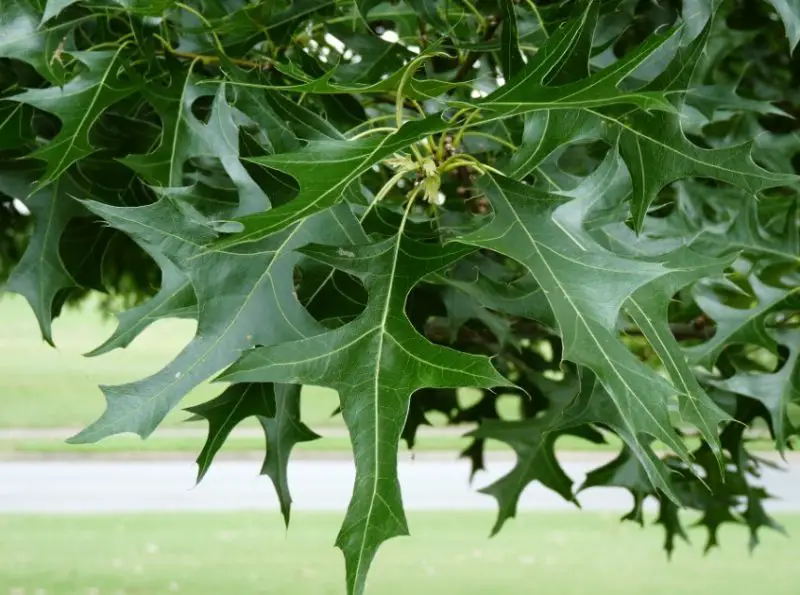
Nuttall Oak is a fast-growing, resilient red oak species native to the Mississippi River Valley and Gulf Coast region. It can reach heights of 60 to 80 feet, with a broad, pyramidal to oval canopy. The bark is dark gray with shallow ridges, and the tree often develops a symmetrical, upright form. Known for its rapid growth and brilliant fall foliage, Nuttall Oak is becoming increasingly popular in landscaping.
Leaves are deeply lobed with 5 to 7 narrow, pointed lobes and large sinuses. They are glossy green throughout the growing season and transition to striking shades of red, orange, or maroon in autumn. The acorns are among the most prolific of the red oaks, maturing in two years and often covering the ground in mast years. Each acorn has a shallow, flattened cap and is favored by deer, ducks, and squirrels.
This oak performs well in USDA zones 6 to 9 and prefers moist, well-drained, acidic soils. It tolerates heavy clay, wet sites, and even occasional flooding, making it ideal for riparian areas and lowlands. Nuttall Oak requires full sun and benefits from mulching and occasional deep watering during dry spells. Its low-maintenance nature and strong structure make it ideal for public plantings and reclamation projects.
Cherrybark Oak (Quercus pagoda)

Cherrybark Oak is a tall, fast-growing tree native to the southeastern United States. Often reaching heights of 70 to 100 feet, it develops a strong central trunk and a broad, rounded crown. Its name comes from its bark, which resembles that of a black cherry tree—dark gray to almost black, with flaky, scaly ridges. This species is one of the most valuable timber oaks due to its strong, straight wood.
The leaves are glossy green and shaped similarly to those of Southern Red Oak but with a more uniform, pagoda-like outline. Typically, they have 5 to 11 lobes and bristle tips, with smooth, rounded sinuses. In fall, the foliage turns rich shades of red or yellowish-orange. The acorns are small to medium-sized and sit in shallow, saucer-like caps. They ripen in their second year and are an important wildlife food.
Cherrybark Oak thrives in USDA zones 6 through 9 and favors bottomland soils that are moist but well-drained. It grows best in full sun and can tolerate seasonal flooding, making it a great choice for river valleys and floodplains. This oak requires little care once established, though it benefits from mulching and watering during droughts. Its rapid growth and straight form make it ideal for shade and reforestation.
Texas Red Oak (Quercus buckleyi)

Texas Red Oak, also known as Buckley’s Oak, is a small to medium-sized deciduous oak native to central Texas and southern Oklahoma. It usually reaches a height of 30 to 50 feet with a rounded, spreading crown. It is known for its compact size, drought tolerance, and vibrant fall colors, making it highly desirable in urban and suburban landscapes in hot, dry regions.
The leaves resemble those of the Shumard Oak but are smaller, typically 3 to 5 inches long with 5 to 7 pointed lobes and deep sinuses. In spring and summer, the leaves are dark green and leathery; in fall, they turn brilliant shades of red, orange, or burgundy, often persisting into winter. The acorns are small and squat, with a shallow, scaly cap covering about one-third of the nut.
Texas Red Oak is well-suited to USDA zones 6 through 9. It prefers full sun and well-drained limestone or sandy soils but is adaptable to a variety of sites. Once established, it requires minimal water and is an excellent choice for drought-prone regions. Occasional pruning to shape the canopy and remove dead wood can enhance its natural form and improve airflow through the crown.
Bear Oak (Quercus ilicifolia)
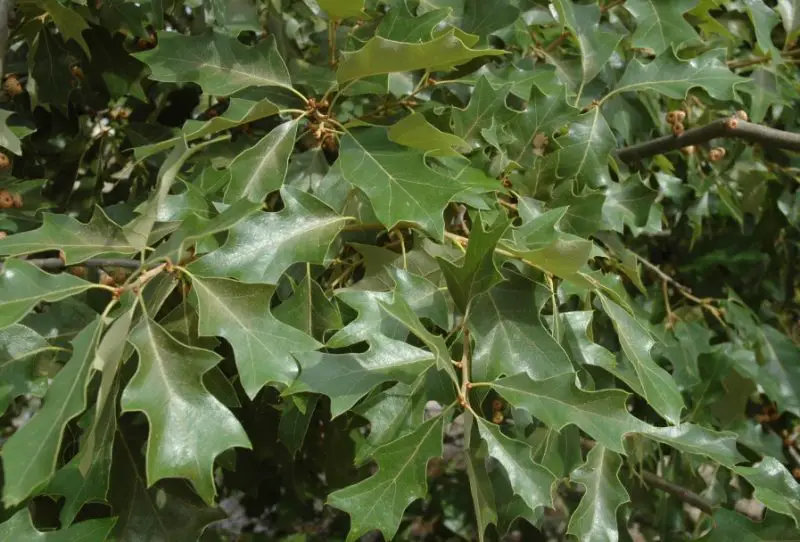
Bear Oak is a small, shrubby oak species native to the northeastern United States and parts of the Appalachian Mountains. It typically grows between 6 and 20 feet tall and often forms thickets through root suckering. This oak is well-adapted to harsh, dry environments and is commonly found in rocky, sandy soils, especially in open barrens and pine-oak scrublands.
The leaves are small, leathery, and resemble those of holly—oval with 3 to 7 shallow, bristled lobes and thick, glossy surfaces. They are dark green on top and lighter underneath. In fall, the foliage turns reddish-brown. Bear Oak produces small acorns in clusters, each with a bowl-shaped cap covering about one-third of the nut. These acorns are a favorite food source for bears, giving the tree its common name.
Bear Oak grows best in USDA zones 5 through 7 and prefers full sun with well-drained, acidic soils. It is ideal for difficult or nutrient-poor sites, particularly in regions with sandy or gravelly substrates. This oak requires little maintenance, making it useful for naturalistic plantings, erosion control, and wildlife habitats. Occasional pruning can help maintain its shape and prevent excessive thicket formation.
White Oak (Quercus alba)

White Oak is one of the most iconic and widespread oak species in North America, valued for its strength, longevity, and majestic appearance. It typically reaches heights of 50 to 80 feet, though old specimens can grow over 100 feet tall. The bark is light gray and becomes plated with age, contributing to its name. White Oak has a strong, rounded crown and is commonly used in parks, large yards, and naturalized landscapes.
The leaves are oblong to oval, 4 to 9 inches long, and deeply lobed with rounded tips. They emerge pinkish in spring, mature to a deep green in summer, and often turn a beautiful mix of red, purple, and burgundy in the fall. The acorns are relatively short and fat, with a warty cap that covers about one-quarter of the nut. They mature in one growing season and are highly attractive to deer, birds, and small mammals.
White Oak grows best in USDA hardiness zones 3 through 9. It thrives in full sun and well-drained, slightly acidic to neutral soils, though it can tolerate clay and sandy conditions. This oak is relatively slow-growing but extremely hardy and long-lived. Once established, it requires minimal care, though it benefits from occasional watering during prolonged droughts. Its deep root system makes it a stable and wind-resistant choice for landscapes.
Bur Oak (Quercus macrocarpa)

Bur Oak is a massive and rugged oak species native to the central and eastern United States. Known for its towering size and thick, corky bark, it can grow between 70 and 90 feet tall with a broad, open crown. The bark is deeply furrowed and often exhibits pronounced ridges. Bur Oak is well-known for its adaptability to harsh prairie conditions, including drought, fire, and poor soils.
Its leaves are large—up to 12 inches long—and have a distinctive hourglass shape, with deeply incised lobes and a wide central portion. They are dark green on top and pale underneath, often turning yellow-brown in autumn. The acorns are the largest of any North American oak, measuring up to 1.5 inches long, with a fringed, hairy cap that covers more than half the nut. These large acorns are critical food sources for turkeys, deer, and rodents.
Bur Oak is hardy in USDA zones 3 through 8 and grows well in full sun and a variety of soil types, including alkaline and clay soils. It is highly drought-tolerant once established and requires very little maintenance. Because of its size, it’s best suited for large landscapes, open fields, or restoration projects. Young trees should be pruned for strong structure, and mulching helps protect roots in the early years.
Post Oak (Quercus stellata)

Post Oak is a slow-growing, drought-tolerant oak species native to the southeastern and central United States. It typically reaches 30 to 50 feet in height with a short, thick trunk and a broad, irregular crown. Its name comes from its historical use for fence posts due to its durable, rot-resistant wood. Post Oak is commonly found in dry uplands, open woods, and rocky ridges.
The leaves are leathery and distinctly cross-shaped, usually with five lobes and a squared-off appearance. They are dark green above and paler below, often with dense hairs on the underside. The fall color is generally a muted brown or yellow. The acorns are small, about 0.5 to 1 inch long, with a cap covering about one-third of the nut. They mature in one season and are eaten by many species of wildlife.
Post Oak grows best in USDA zones 5 through 9 and prefers full sun with well-drained, sandy, or rocky soils. It thrives in poor, dry soils where other oaks might struggle, making it an excellent choice for xeriscaping or native plant gardens. This oak requires little care once established and is ideal for naturalistic or wildlife-friendly plantings. Avoid overwatering, as Post Oak does not tolerate poorly drained soils.
Swamp White Oak (Quercus bicolor)
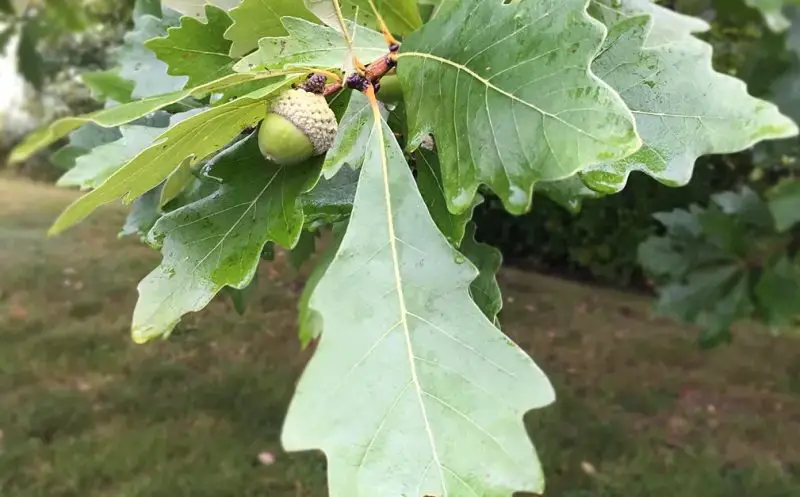
Swamp White Oak is a moisture-loving tree native to lowlands, floodplains, and wet woods of the northeastern and central United States. It typically grows 50 to 70 feet tall and forms a broad, rounded crown. The bark is light gray and becomes scaly with age, often peeling in plates. Despite its preference for wet soils, it is surprisingly adaptable and often used in urban landscaping.
The leaves are oval to oblong with shallow lobes and coarse teeth, usually 4 to 7 inches long. They are dark green and shiny above, with a silvery-white underside, giving the tree its name. In fall, the foliage may turn golden brown or russet. The acorns are about 1 inch long and sit in a bowl-shaped cap that covers about half the nut. They mature in one season and are attractive to many types of wildlife.
Swamp White Oak is hardy in USDA zones 4 through 8. It prefers full sun and acidic to slightly alkaline soils, especially those that are moist or periodically flooded. However, it also performs well in drier soils once established. This oak benefits from mulching to conserve soil moisture and may need occasional deep watering during drought. It is an excellent tree for rain gardens, stream banks, and large landscapes.
Overcup Oak (Quercus lyrata)

Overcup Oak is a flood-tolerant oak species native to the southeastern United States, often found in bottomlands, swamps, and poorly drained soils. It grows 40 to 60 feet tall and develops a rounded or spreading crown with thick, leathery branches. The bark is gray to brown and becomes deeply ridged with age. Overcup Oak is named for its acorns, which are nearly enclosed by their caps.
The leaves are oblong to oval with 5 to 9 rounded lobes, typically about 4 to 8 inches long. They are glossy green on top and pale, fuzzy underneath, sometimes turning yellow or brown in fall. The acorns are unique—they are almost entirely covered by their thick, saucer-shaped caps, which help them float during floods. These buoyant acorns are dispersed by water and are an important adaptation for wetland environments.
Overcup Oak thrives in USDA zones 5 through 9 and prefers full sun with clay, loamy, or silty soils that retain moisture. It is well-suited for planting in flood-prone or poorly drained areas and makes an excellent addition to riparian buffers or wetland restorations. Once established, it requires little care and is resistant to many pests and diseases. This oak can also tolerate brief periods of drought but performs best with consistent moisture.
Chinkapin Oak (Quercus muehlenbergii)
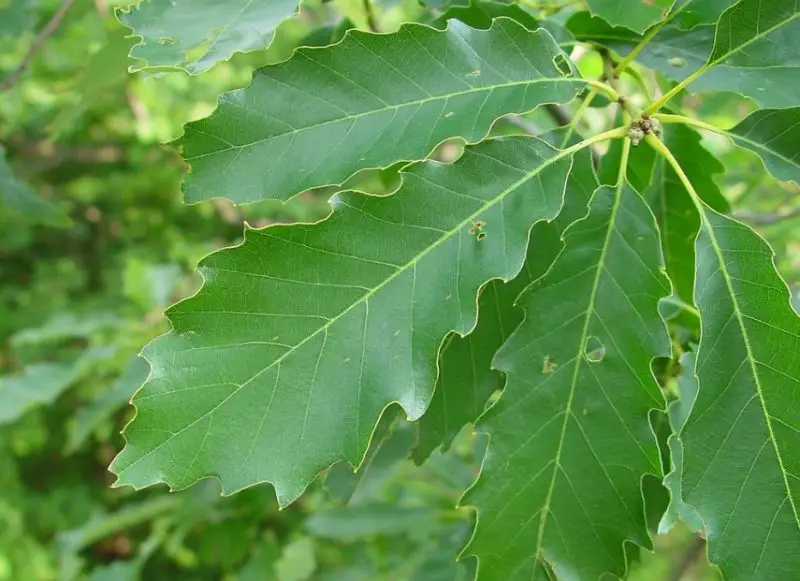
Chinkapin Oak is a medium to large deciduous tree known for its distinctive foliage and limestone tolerance. Native to central and eastern parts of the United States, this species typically grows between 40 and 70 feet tall, forming a rounded crown with strong, spreading branches. The bark is light gray and becomes rough and flaky with age, somewhat resembling the bark of White Oak in texture.
The leaves of Chinkapin Oak are narrow, oblong, and coarsely toothed, resembling those of the chestnut tree. They range from 4 to 6 inches in length, with a lustrous dark green upper surface and paler underside. In fall, the foliage turns an attractive yellow to orangish-brown. Acorns are about 0.5 to 1 inch long, with a thin cap covering one-third of the nut. These acorns mature in one growing season and are a favored food source for wildlife.
Chinkapin Oak thrives in USDA hardiness zones 3 through 9 and is well-adapted to alkaline soils, particularly those over limestone bedrock. It prefers full sun and well-drained sites but is remarkably drought-tolerant once established. Minimal care is required aside from occasional watering during prolonged dry periods. This oak is an excellent choice for naturalized landscapes, parks, and upland sites where other oaks may struggle with soil alkalinity.
Dwarf Chinkapin Oak (Quercus prinoides)
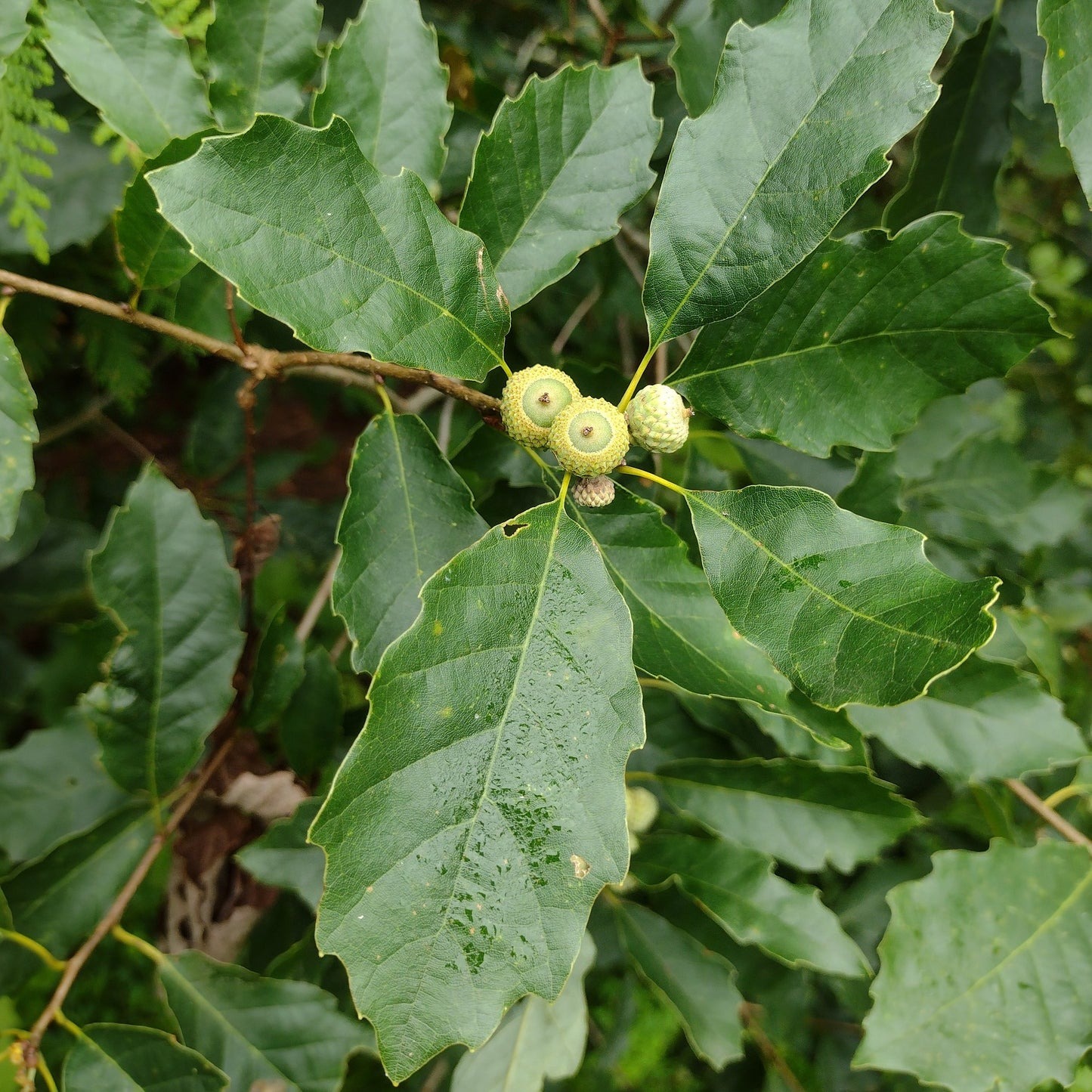
Dwarf Chinkapin Oak is a shrubby, small-statured relative of the Chinkapin Oak, typically reaching 8 to 20 feet in height. This species is native to the eastern and central United States and often forms colonies by root suckering, making it ideal for erosion control or natural thickets. Its compact size and adaptability make it a unique and valuable addition to smaller landscapes.
The leaves are similar in shape to those of its larger cousin—narrow, oblong, and sharply toothed—but are generally smaller, measuring 3 to 5 inches in length. They are bright green above and whitish beneath, with golden-brown hues in the fall. The small acorns, less than 1 inch long, are produced in abundance and mature in a single season. Wildlife such as birds and small mammals are especially drawn to these nutrient-rich nuts.
Dwarf Chinkapin Oak grows best in USDA zones 4 through 8. It favors full sun and well-drained soils but is highly tolerant of dry, rocky, and even poor-quality sites. Due to its shrubby form, it can be pruned as needed or left to form natural clumps. This oak is particularly useful in restoration projects, native plant gardens, and sunny woodland edges. Its resistance to pests and diseases makes it an easy-care choice for sustainable plantings.
Chestnut Oak (Quercus montana)
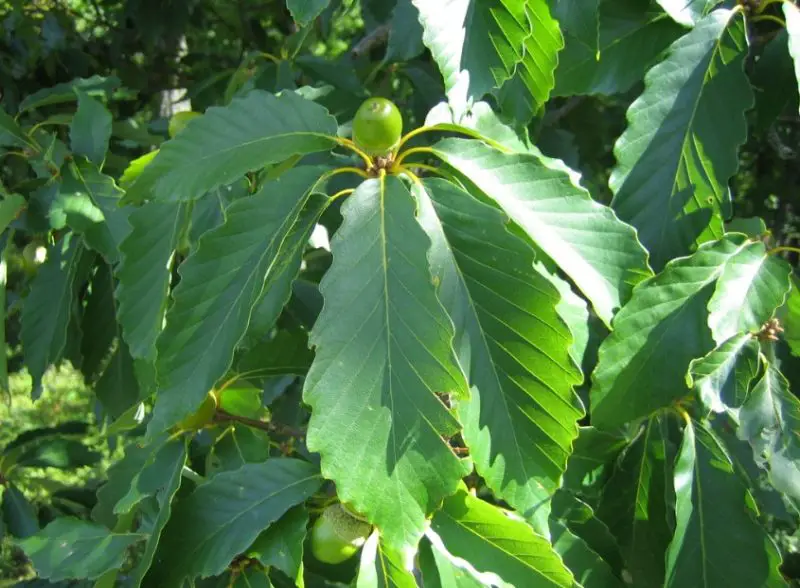
Chestnut Oak is a rugged, slow-growing tree native to the Appalachian Mountains and surrounding areas. It typically reaches 60 to 70 feet tall and develops a stout, straight trunk with thick, deeply furrowed bark that is almost black in mature trees. This deeply ridged bark is among the thickest of all oak species and helps protect the tree from fire and environmental stress.
Its leaves are large, typically 4 to 8 inches long, with rounded teeth along the margins that give them a resemblance to chestnut leaves—hence the name. They are dark green and glossy on top and paler beneath, turning yellowish-brown in the fall. The acorns are relatively large, 1 to 1.5 inches long, with a broad cap covering about half the nut. These sweet acorns are highly desirable to a variety of wildlife species.
Chestnut Oak grows in USDA zones 4 through 8 and prefers dry, rocky upland soils, particularly those on slopes and ridges. It thrives in full sun and is extremely tolerant of drought and poor soil conditions. Because of its durability and strong wood, it is often found in rugged natural areas, though it can also be planted in large landscapes or restoration projects. Regular mulching and light pruning in youth will help establish a healthy form.
Live Oak (Quercus virginiana)

Live Oak is a majestic evergreen oak native to the southeastern United States, particularly well-known for its sprawling limbs and iconic presence in coastal regions. It generally grows 40 to 80 feet tall but spreads much wider, often exceeding 100 feet in canopy width. Its limbs frequently dip toward the ground before arching upward, giving the tree its classic southern silhouette. The bark is dark and blocky, adding to its aged and sturdy appearance.
The leaves of Live Oak are thick, leathery, and dark green, remaining on the tree year-round. They are typically 2 to 4 inches long, oval-shaped, and have smooth edges. In spring, old leaves are briefly shed and replaced by fresh new growth. The acorns are small, about 1 inch long, and taper at the end, with a shallow cap. These nuts are produced in abundance and support a wide range of wildlife, including squirrels, deer, and birds.
Live Oak is best suited for USDA hardiness zones 8 through 10. It thrives in full sun and tolerates a wide range of soils, including sandy, clay, and loamy types, as long as they are well-drained. This species is especially adapted to coastal environments and is highly resistant to wind, salt, and drought. Young trees benefit from structural pruning, and established trees need little care. Its impressive size makes it best suited for large landscapes, parks, or historic settings.
Gambel Oak (Quercus gambelii)
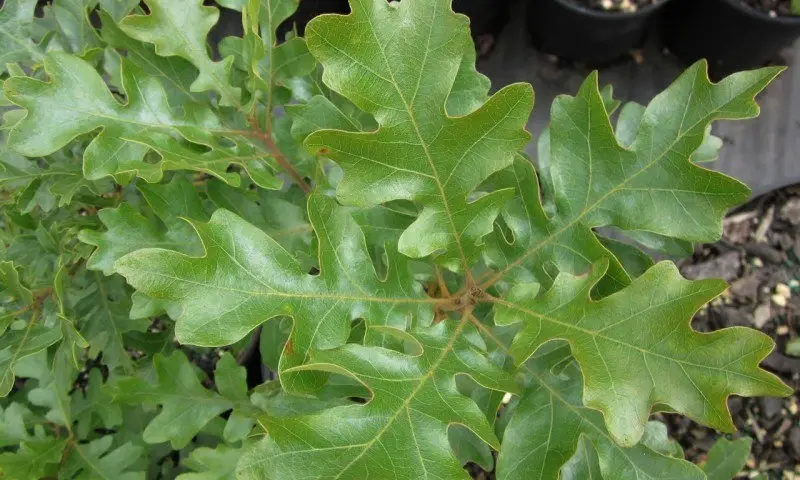
Gambel Oak is a medium-sized deciduous tree native to the western United States, particularly found in the mountainous regions of Arizona, Colorado, and New Mexico. Typically growing to heights of 15 to 30 feet, it often forms dense thickets through the process of sprouting from its root system. The tree has a bushy appearance, with multiple trunks and a rounded crown. Its bark is light gray, rough, and slightly ridged.
The leaves of Gambel Oak are small to medium-sized, measuring 2 to 5 inches in length. They are deeply lobed, with a glossy dark green color during the growing season, turning red to yellow in fall. The acorns produced by this species are small, about 0.5 to 1 inch long, with a shallow cup covering one-quarter of the nut. These acorns are an important food source for wildlife, including squirrels and birds.
Gambel Oak is well-suited for USDA zones 4 through 8, thriving in dry, rocky soils and open woodlands. It is highly drought-tolerant once established and prefers full sun to partial shade. Gambel Oak requires minimal care but benefits from occasional pruning to maintain its shape, especially when growing in dense clusters. It is an excellent choice for xeriscaping and naturalizing landscapes in arid climates.
California Black Oak (Quercus kelloggii)

California Black Oak is a large, deciduous oak tree native to the western United States, particularly found in California and parts of Oregon. This species can grow up to 50 feet tall, with a broad, rounded canopy. The bark is dark gray to black and becomes deeply furrowed as the tree matures, providing a unique texture. Its branches are spreading, creating an attractive silhouette.
The leaves of California Black Oak are lobed, with 5 to 9 pointed lobes. They are large, ranging from 5 to 9 inches long, with a deep green color on the upper side and a pale, woolly underside. In the fall, the leaves turn brilliant yellow to red, adding significant visual appeal. The acorns are large, about 1 to 1.5 inches long, with a wide, deep cup that covers about one-third of the nut. These acorns are highly favored by wildlife such as deer, birds, and squirrels.
California Black Oak thrives in USDA zones 7 through 9 and prefers well-drained, slightly acidic soils in full sun to partial shade. It is tolerant of dry conditions once established but benefits from occasional deep watering in the summer months. The tree is a valuable shade tree in large landscapes, and its acorns are an important food source for various wildlife species. Regular pruning is recommended to remove dead or damaged wood and promote healthy growth.
Canyon Live Oak (Quercus chrysolepis)

Canyon Live Oak, also known as Golden Oak, is a medium to large evergreen oak native to the southwestern United States, particularly in California and Arizona. It typically grows between 20 and 50 feet tall, with a broad, irregular canopy. The bark is dark gray to black and somewhat smooth in younger trees, becoming rougher and more furrowed with age. Its branches are stout and horizontally spreading, giving the tree a rounded form.
The leaves of Canyon Live Oak are leathery, with a glossy green upper surface and a paler, slightly hairy underside. They are elliptical in shape, with a smooth or lightly toothed edge, typically measuring 2 to 5 inches in length. The acorns are medium-sized, around 1 inch long, with a shallow cup covering about one-third of the nut. The acorns ripen in the fall and are a key food source for animals in its native range.
Canyon Live Oak thrives in USDA hardiness zones 7 through 9, preferring dry, rocky soils in full sun to partial shade. It is drought-tolerant once established, making it ideal for xeriscaping and low-water landscapes. This oak is slow-growing but can live for several centuries, making it a long-term addition to the landscape. Little maintenance is required, although occasional pruning to remove dead or damaged limbs will help maintain its shape and health.
Interior Live Oak (Quercus wislizeni)
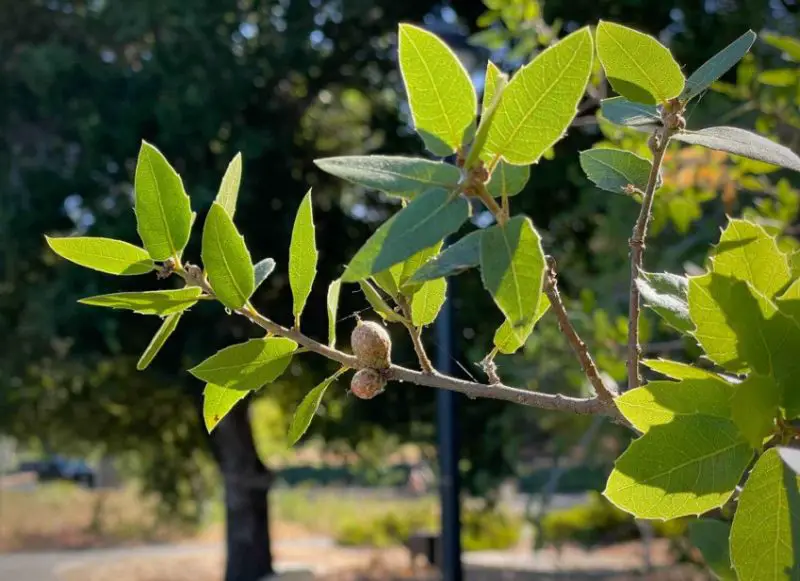
Interior Live Oak is a medium-sized evergreen oak tree native to the southwestern United States, particularly in parts of Arizona, New Mexico, and Texas. Typically growing to heights of 30 to 50 feet, it has a broad, dense canopy of thick, leathery leaves. The bark is dark brown or gray, often with a smooth texture in younger trees but becoming more furrowed and rougher with age. Its sturdy branches spread wide, creating a dense shade.
The leaves of Interior Live Oak are leathery and dark green on the upper side, with a pale, slightly hairy underside. They are oval to lance-shaped, measuring 1.5 to 4 inches long, with a smooth edge. The acorns are small to medium-sized, around 0.5 to 1 inch long, with a shallow cup that covers about one-third of the nut. These acorns mature in one season and are consumed by a variety of wildlife, including birds and small mammals.
Interior Live Oak thrives in USDA zones 7 through 9 and prefers dry, rocky, or clay soils, often found in arid and semi-arid regions. It is well-suited to full sun and is highly drought-tolerant once established, making it an excellent choice for xeriscaping and low-water-use landscapes. This species requires minimal care aside from occasional pruning and the removal of dead wood. Its evergreen foliage makes it a valuable year-round shade tree.
Engelmann Oak (Quercus engelmannii)
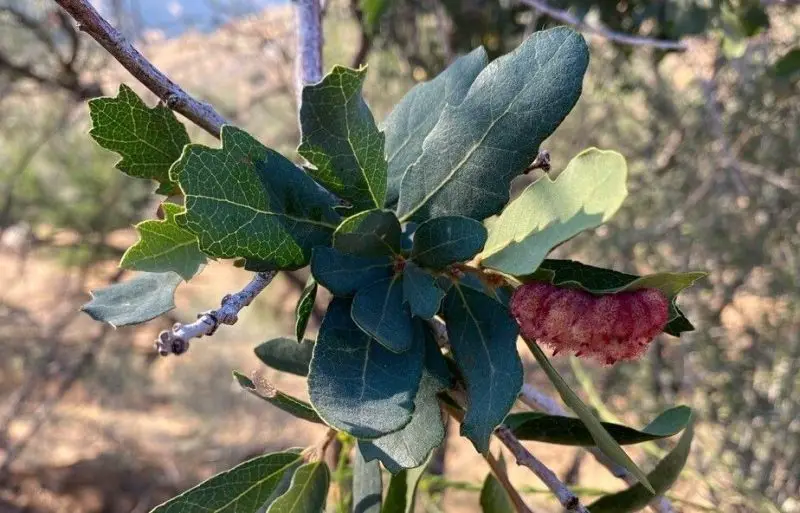
Engelmann Oak is a medium-sized, evergreen oak tree native to southern California, Arizona, and northern Mexico. It typically reaches heights of 30 to 50 feet, with a rounded, spreading canopy and a smooth, gray to light brown bark that becomes rougher with age. This oak often grows in hilly or mountainous areas, with its broad canopy providing excellent shade in its native range.
The leaves of Engelmann Oak are thick and leathery, with a dark green color on the upper side and a pale, somewhat fuzzy underside. They are oval to elliptical, measuring 2 to 5 inches in length, with a slightly undulate edge. The acorns are small, around 1 inch long, and have a shallow cup that covers one-third of the nut. These acorns mature quickly and are an essential food source for local wildlife, including birds and small mammals.
Engelmann Oak thrives in USDA hardiness zones 8 through 10 and prefers well-drained soils in full sun or partial shade. It is drought-tolerant once established and is often used in xeriscaping projects in its native range. While it requires minimal maintenance, occasional pruning can help maintain its shape and remove dead or damaged branches. Engelmann Oak is well-suited to landscapes where a drought-resistant, evergreen shade tree is desired.
Coast Live Oak (Quercus agrifolia)
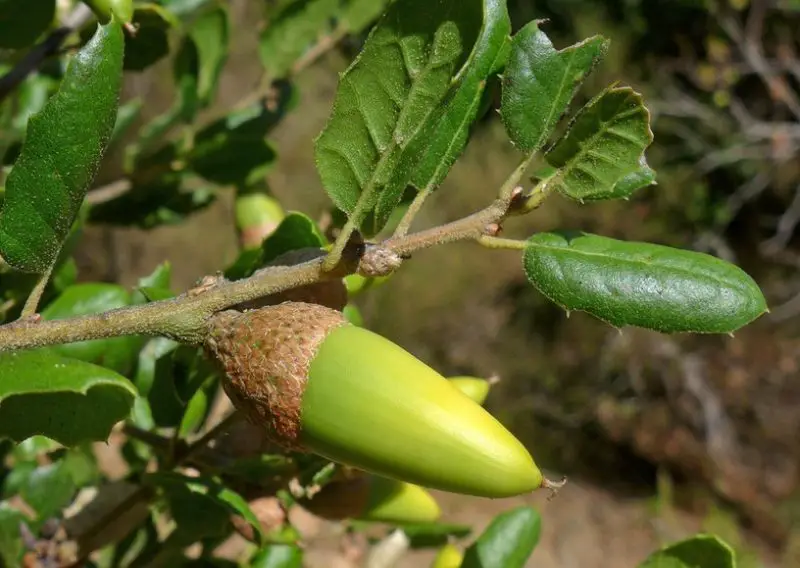
Coast Live Oak is an evergreen tree native to the coastal regions of California. It typically grows to a height of 30 to 60 feet, although it can sometimes reach up to 80 feet. This oak has a dense, rounded canopy and a broad, spreading form. The bark is dark gray to black and becomes rough and fissured with age. Its branches are thick, creating a dense shade beneath the tree. Coast Live Oak thrives in coastal environments, often found in hillsides or valley floors.
The leaves of Coast Live Oak are dark green, leathery, and glossy, with a slightly spiny margin. They are oval-shaped, measuring 2 to 4 inches in length. The acorns produced by this oak are small, about 1 inch long, and have a shallow cup that covers about one-quarter of the nut. These acorns ripen in fall and are a vital food source for a variety of wildlife, including birds and mammals.
This oak thrives in USDA hardiness zones 8 through 10, where it prefers well-drained, slightly acidic soils in full sun to partial shade. Coast Live Oak is drought-tolerant once established, making it ideal for water-wise landscaping in California and similar climates. The tree requires minimal care but benefits from periodic pruning to remove dead or damaged branches. It is an excellent shade tree and provides habitat for various bird species.
Blue Oak (Quercus douglasii)
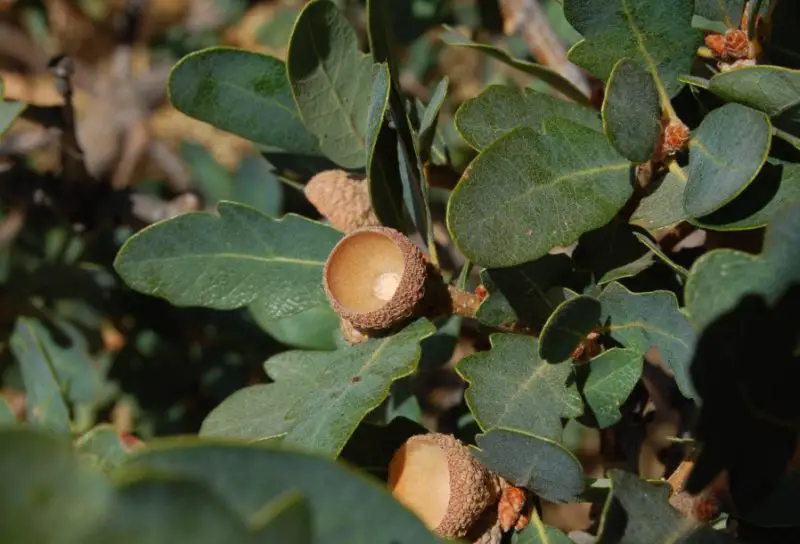
Blue Oak is a deciduous tree native to the foothills of California, particularly found in dry, open woodlands. This species typically grows between 30 to 60 feet tall, with a broad, spreading canopy. The bark is light gray or whitish, smooth when young, but becoming slightly furrowed with age. Its branches are stout and widely spreading, giving it an open and airy appearance.
The leaves of Blue Oak are small to medium-sized, measuring about 2 to 4 inches in length. They have a distinctive blue-gray color, especially on the underside, giving the tree its name. The leaves are lobed, with a smooth or slightly wavy margin. Blue Oak produces small acorns, about 1 inch in length, with a shallow cup that covers about one-quarter of the nut. These acorns mature in fall and provide food for various animals, including deer and small rodents.
Blue Oak thrives in USDA zones 6 through 9 and prefers dry, rocky, or clay soils in full sun. It is highly drought-tolerant once established, making it an excellent choice for xeriscaping. While this tree requires minimal maintenance, it benefits from periodic pruning to maintain a healthy structure and remove dead or damaged limbs. Blue Oak is a valuable addition to landscapes in dry climates, providing shade and habitat for local wildlife.
Oregon White Oak (Quercus garryana)
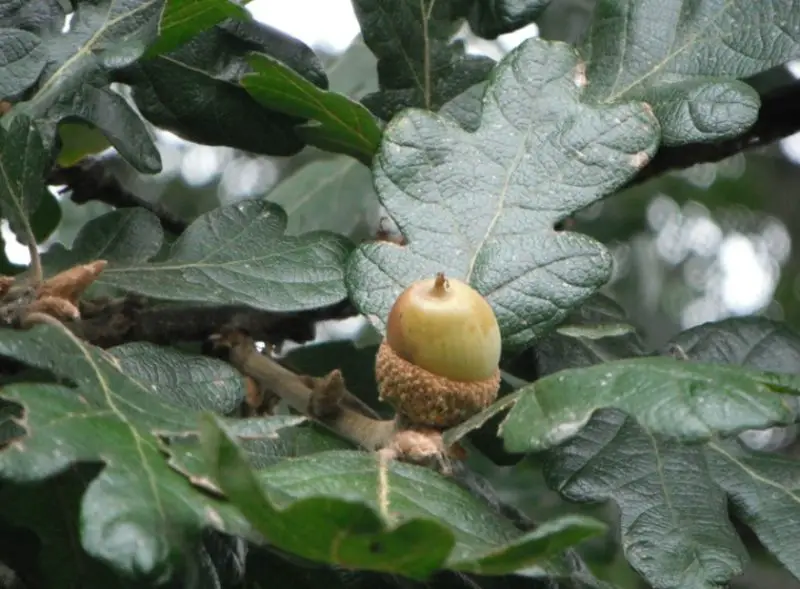
Oregon White Oak is a large, deciduous tree native to the Pacific Northwest, particularly found in Oregon, Washington, and northern California. It typically grows to a height of 50 to 80 feet, with a broad, rounded canopy. The bark is light gray to brown and becomes deeply furrowed with age, giving it a distinctive appearance. The branches are stout and spreading, creating a strong, symmetrical form.
The leaves of Oregon White Oak are large, with 5 to 7 lobes and a smooth or slightly wavy edge. They measure 4 to 8 inches long and have a deep green color on the upper side, with a pale, downy underside. In the fall, the leaves turn yellow to orange, adding vibrant color to the landscape. The acorns produced by Oregon White Oak are large, about 1 to 1.5 inches long, with a deep, shallow cup covering about one-third of the nut. These acorns are a vital food source for wildlife, including squirrels, birds, and deer.
Oregon White Oak thrives in USDA hardiness zones 6 through 9 and prefers well-drained soils, often in valleys, riverbanks, or upland areas. This tree is moderately drought-tolerant but benefits from occasional watering during dry spells. Oregon White Oak is relatively low-maintenance, requiring minimal care, though pruning to remove dead or damaged limbs is recommended. It makes an excellent shade tree for large landscapes and a valuable habitat for wildlife.
Sand Post Oak (Quercus margarettae)

Sand Post Oak is a small to medium-sized deciduous oak tree native to the southeastern United States, primarily found in sandy soils of Alabama, Georgia, and the Florida panhandle. This oak typically reaches heights of 20 to 40 feet, with a rounded canopy and an irregular shape. The bark is light gray, smooth in younger trees, but becomes more furrowed and rough as the tree matures. Its branches are stout and spread widely, often creating a dense canopy of foliage.
The leaves of Sand Post Oak are small to medium-sized, measuring 3 to 5 inches in length. They are typically broad, with 3 to 5 shallow lobes, and have a dark green color on the upper surface, turning yellow in the fall. The acorns of Sand Post Oak are small, about 1 inch long, with a shallow, cup-like cap that covers about one-quarter of the nut. These acorns mature in the fall and provide an essential food source for various wildlife species, such as birds and small mammals.
Sand Post Oak thrives in USDA zones 8 through 9, preferring well-drained, sandy, or loamy soils in full sun. It is highly drought-tolerant and is ideal for landscapes in sandy or dry conditions. This oak requires minimal maintenance and is well-suited for low-water-use landscapes. It is a valuable tree for wildlife habitat and can be used in various landscaping projects, particularly in dry, well-drained soils.
European and Mediterranean Oaks
English Oak (Quercus robur)

English Oak is a large, deciduous tree native to Europe and parts of Asia, known for its majestic stature and longevity. It typically grows between 60 to 100 feet tall, with a wide-spreading crown that provides excellent shade. The bark is rough and deeply furrowed, often light gray or brownish in color. The tree’s branches spread out symmetrically, creating a broad, rounded canopy. English Oak is highly prized for its wood, which is dense and durable, commonly used in construction and furniture-making.
The leaves of English Oak are lobed, with deep, rounded sinuses, and typically measure 4 to 7 inches in length. They are dark green on the upper surface and pale underneath, turning yellow and red in the fall. The acorns of English Oak are medium-sized, about 1 inch in length, with a deep cup that covers about one-third of the nut. The acorns ripen in autumn and are an important food source for a wide variety of wildlife, including squirrels, birds, and deer.
This oak thrives in USDA hardiness zones 4 through 8, preferring deep, well-drained soils in full sun. English Oak is relatively low-maintenance but benefits from occasional pruning to remove dead or damaged branches. Once established, it is moderately drought-tolerant and can live for centuries. It is a popular choice in large landscapes, parks, and natural woodlands, providing substantial ecological value and shade.
Sessile Oak (Quercus petraea)
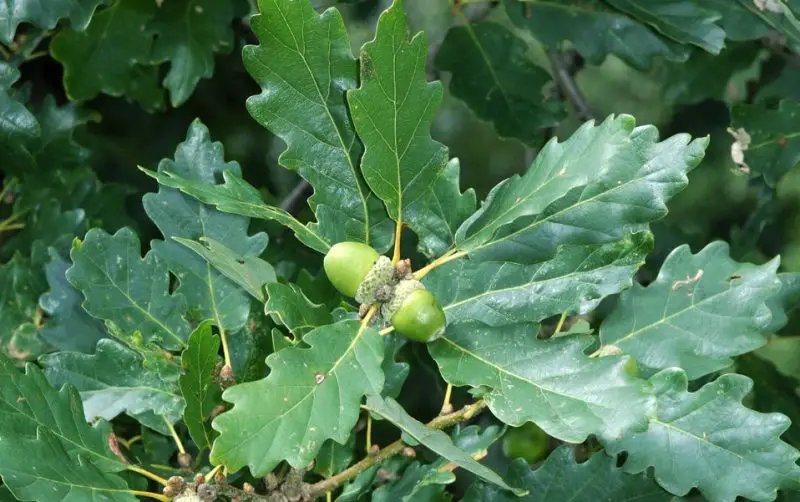
Sessile Oak, also known as the Irish Oak, is a closely related species to the English Oak, native to Europe and parts of Asia. It typically reaches heights of 50 to 80 feet, with a broad, spreading canopy. The bark is smooth when young, turning rough and deeply fissured with age, resembling the texture of the English Oak. Its branches grow in a more upright manner, forming a less rounded canopy compared to its relative. Sessile Oak is highly valued for its durable wood, which is used in shipbuilding and furniture production.
The leaves of Sessile Oak are similar to those of English Oak, with lobes that are deep and rounded, measuring 4 to 8 inches in length. The main difference lies in the leaf’s petiole, which is much shorter compared to the English Oak, making the leaves appear more sessile (without stalks). The acorns of Sessile Oak are medium-sized, about 1 inch long, with a cup that only partially covers the nut. They ripen in autumn and are an important food source for various species of wildlife.
Sessile Oak thrives in USDA zones 5 through 8, preferring well-drained, fertile soils in full sun or partial shade. It is moderately drought-tolerant once established and benefits from occasional pruning to maintain its structure. Sessile Oak is well-suited for large landscapes and natural forests, offering shade, aesthetic value, and ecological benefits.
Holm Oak / Holly Oak (Quercus ilex)
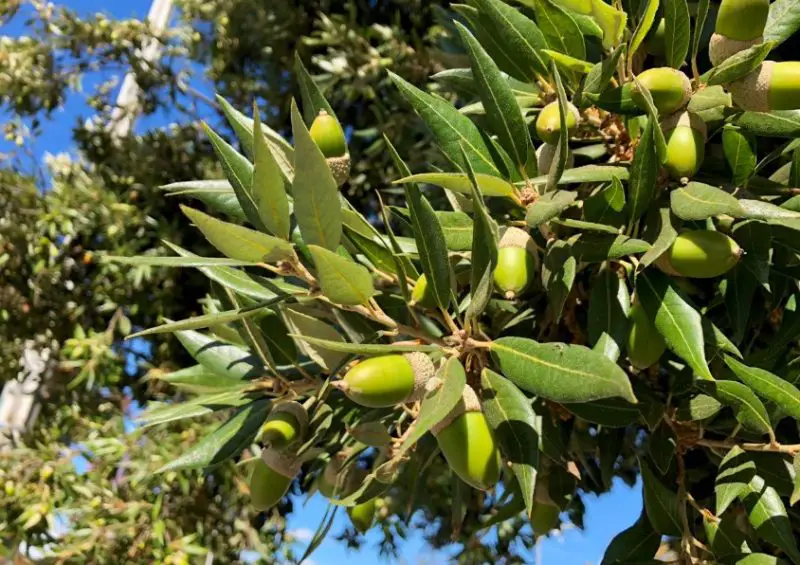
Holm Oak, also known as Holly Oak, is an evergreen oak tree native to the Mediterranean region. It is well-adapted to dry, coastal environments and typically grows between 30 to 50 feet tall. The bark of Holm Oak is smooth and grayish-brown when young, becoming darker and rougher with age. Its branches are dense and form a rounded canopy, providing year-round shade. This oak is highly resistant to drought and can tolerate a variety of soil conditions, making it an excellent choice for xeriscaping.
The leaves of Holm Oak are leathery, dark green, and glossy, resembling holly leaves, which is how it gets its alternate name. They are about 2 to 4 inches in length, with sharp, spiny margins. The acorns produced by Holm Oak are small, around 1 inch in length, with a shallow cup that covers about one-quarter of the nut. These acorns ripen in the fall and are a vital food source for birds, squirrels, and other wildlife.
Holm Oak thrives in USDA zones 8 through 10, preferring well-drained, slightly acidic soils in full sun. It is highly drought-tolerant once established and is a great tree for dry landscapes. Holm Oak requires minimal care and benefits from occasional pruning to maintain a tidy shape. It is a popular choice for Mediterranean-style gardens and coastal environments, offering both aesthetic and ecological value.
Turkey Oak (Quercus cerris)

Turkey Oak is a deciduous tree native to southeastern Europe and Asia Minor. It typically grows to a height of 50 to 70 feet, with a broad, rounded canopy that provides ample shade. The bark of Turkey Oak is grayish-brown and rough, with shallow fissures that become deeper with age. Its branches are stout and spread widely, forming a dense canopy of leaves. This tree is commonly found in forests and woodland areas, particularly in regions with a Mediterranean climate.
The leaves of Turkey Oak are large, deeply lobed, and have a distinctive shape, measuring 4 to 8 inches in length. The lobes are irregularly spaced, giving the leaves a jagged appearance. The acorns of Turkey Oak are large, about 1 to 1.5 inches long, with a deep cup that covers about one-third of the nut. These acorns mature in fall and are a vital food source for wildlife, including squirrels, birds, and deer.
Turkey Oak thrives in USDA hardiness zones 5 through 8, preferring well-drained, fertile soils in full sun or partial shade. It is moderately drought-tolerant and is best suited for large landscapes, parks, and woodlands. Turkey Oak requires little maintenance but benefits from occasional pruning to remove dead or damaged branches. It is a valuable tree for providing shade and supporting local wildlife.
Cork Oak (Quercus suber)

Cork Oak is an evergreen tree native to the Mediterranean region, best known for its bark, which is harvested for cork production. It typically grows to a height of 40 to 60 feet, with a dense, rounded canopy. The bark of Cork Oak is thick and spongy, with a reddish-brown color that is harvested every 9 to 12 years. This tree is a vital resource in cork manufacturing and is highly valued for its environmental sustainability.
The leaves of Cork Oak are leathery, dark green on the upper side and pale on the underside. They are about 2 to 4 inches long, with a smooth or slightly wavy margin. The acorns produced by Cork Oak are small, about 1 inch long, with a shallow cup that covers about one-quarter of the nut. These acorns ripen in autumn and provide food for various wildlife species, including wild boars and squirrels.
Cork Oak thrives in USDA zones 8 through 10, preferring well-drained, slightly acidic soils in full sun. It is highly drought-tolerant once established and can withstand the hot, dry conditions of Mediterranean climates. Cork Oak requires minimal care and benefits from occasional pruning to maintain its shape. It is often planted for its ecological value, as well as for its commercial cork production.
Portuguese Oak (Quercus faginea)
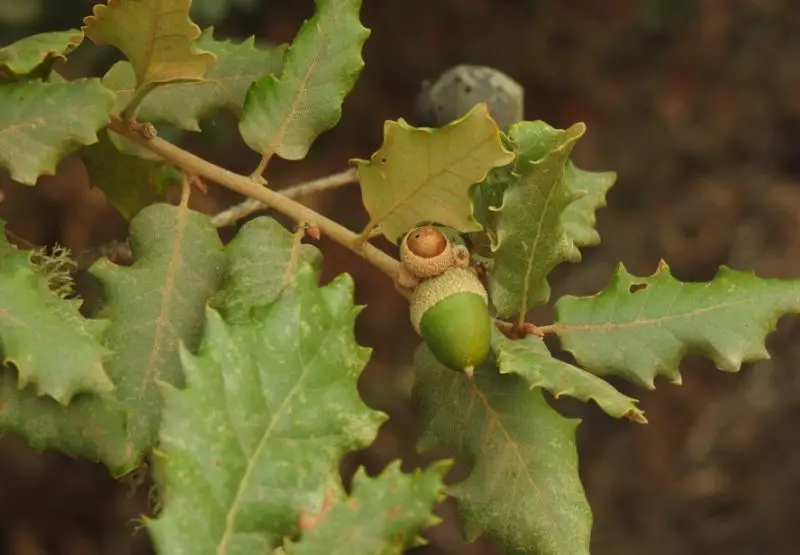
Portuguese Oak is a deciduous tree native to the Iberian Peninsula and parts of North Africa. It typically grows between 50 to 70 feet tall, with a rounded to irregular canopy. The bark is dark gray-brown, becoming rough and fissured with age. The tree’s branches are strong and extend outward, creating a broad, dense canopy that provides ample shade in summer. Portuguese Oak is known for its ability to thrive in poor, rocky soils, making it a resilient tree in arid conditions.
The leaves of Portuguese Oak are 4 to 7 inches long, with a smooth or slightly wavy margin and a deep green color. They turn yellow or brown in the fall before dropping, creating a stunning autumn display. The acorns are small to medium in size, measuring around 1 inch in length, with a shallow cup that covers about one-quarter of the nut. These acorns ripen in late autumn and provide food for wildlife such as squirrels, deer, and various bird species.
Portuguese Oak thrives in USDA hardiness zones 7 through 9, preferring well-drained, rocky soils in full sun. Once established, it is moderately drought-tolerant and requires minimal care. Pruning may be needed to remove damaged or dead branches. Portuguese Oak is an excellent choice for Mediterranean-style landscapes, providing both aesthetic and ecological value in dry, coastal environments.
Hungarian Oak (Quercus frainetto)
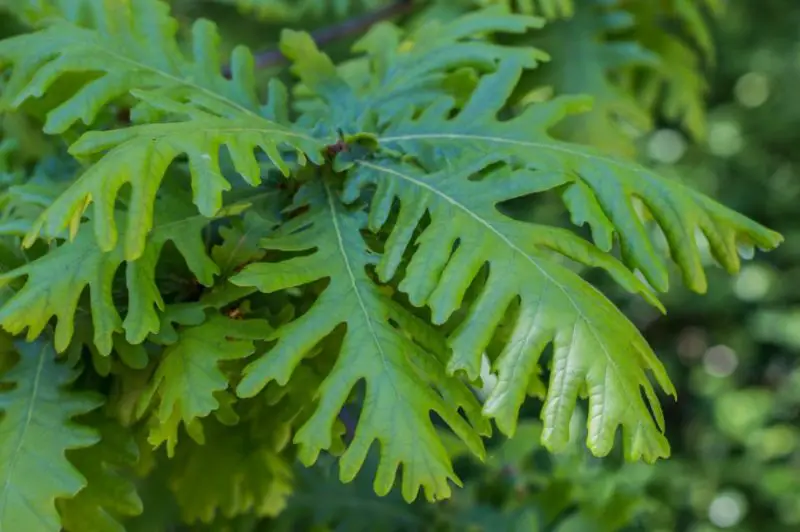
Hungarian Oak is a large deciduous tree native to southeastern Europe, particularly the Balkans and parts of Turkey. It can reach heights of 50 to 70 feet and is known for its sturdy structure and dense canopy. The bark of Hungarian Oak is dark gray or brown, with deep, vertical fissures as the tree matures. Its broad branches form a rounded crown that offers substantial shade. Hungarian Oak is often planted for timber production, as its wood is durable and highly valued.
The leaves of Hungarian Oak are 6 to 10 inches long, with deep lobes that are often pointed. The leaf surface is glossy and dark green in summer, turning golden-yellow in the fall. The acorns are large, about 1.5 inches long, with a cup that covers roughly one-third of the nut. These acorns mature in late fall and are a vital food source for various species of wildlife, including squirrels and birds.
Hungarian Oak thrives in USDA hardiness zones 5 through 8, preferring moist, well-drained soils in full sun. It is moderately drought-tolerant once established but benefits from regular watering during dry periods. Hungarian Oak requires minimal maintenance, but periodic pruning to remove dead or diseased branches will help maintain its shape and health. It is a popular choice for parks, large landscapes, and forests, providing shade and a habitat for local wildlife.
Downy Oak (Quercus pubescens)
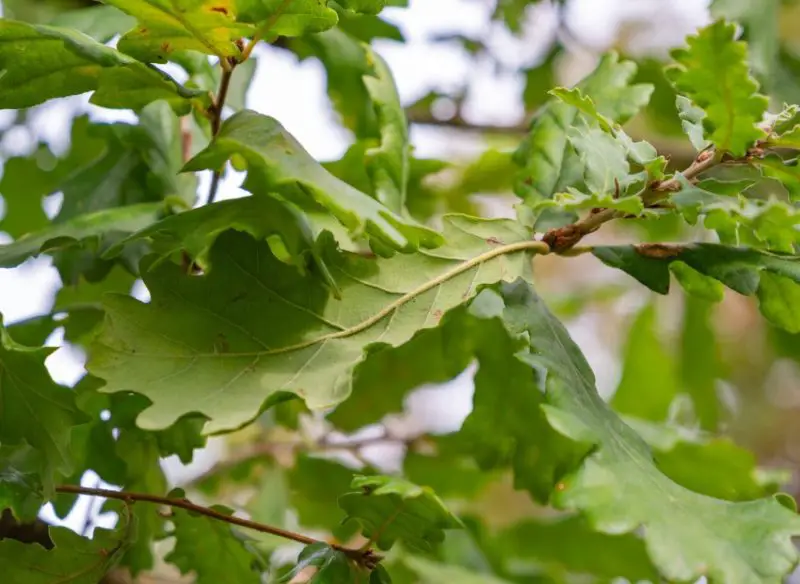
Downy Oak is a medium-sized deciduous tree native to southern Europe and parts of the Mediterranean region. Typically growing to a height of 40 to 60 feet, it has a spreading canopy that provides moderate shade. The bark is light gray to brown, smooth when young but becoming rougher and furrowed as the tree matures. Downy Oak is a hardy species that thrives in areas with harsh winters and hot, dry summers, making it well-suited for Mediterranean climates.
The leaves of Downy Oak are oval-shaped with shallow lobes, covered in fine hairs on the underside, which gives them a silvery appearance. They are about 4 to 6 inches in length and turn yellow or brown in the fall. The acorns are small to medium-sized, about 1 inch long, with a cup that partially covers the nut. These acorns ripen in autumn and provide nourishment for a range of animals, including birds and small mammals.
Downy Oak grows well in USDA hardiness zones 5 through 8, preferring well-drained, rocky soils in full sun or partial shade. It is highly drought-tolerant and can withstand poor soil conditions once established. Minimal care is needed, though periodic pruning is recommended to maintain the tree’s shape. Downy Oak is often planted for its resilience in dry landscapes and is a valuable addition to Mediterranean-style gardens, providing shade and ecological benefits.
Asian Oaks
Japanese Emperor Oak (Quercus dentata)

Japanese Emperor Oak is a large, deciduous tree native to Japan, Korea, and parts of China. It can grow up to 70 feet tall and is known for its elegant, spreading canopy and attractive foliage. The bark of the Japanese Emperor Oak is smooth and gray, becoming more textured as the tree ages. The tree has a rounded crown with long, arching branches that provide dense shade in the summer months. This oak species is often admired for its majestic appearance and is frequently planted in large gardens and landscapes.
The leaves of the Japanese Emperor Oak are large, up to 10 inches long, with sharply toothed edges. The foliage starts as a rich green color in the spring and summer, transitioning to a golden yellow or red in the fall. The acorns of this species are relatively large, measuring about 1 inch long, with a deep, cup-shaped cap that covers nearly half of the nut. These acorns mature in late autumn and are a valuable food source for wildlife, particularly birds and small mammals.
Japanese Emperor Oak thrives in USDA hardiness zones 5 through 8 and prefers well-drained, acidic soils. It requires full sun to partial shade and is moderately drought-tolerant once established. The tree benefits from occasional pruning to maintain its structure and health, though it generally requires minimal maintenance. This species is ideal for large landscapes or as a focal point in parks due to its striking appearance and the shade it provides.
Japanese Evergreen Oak (Quercus acuta)

Japanese Evergreen Oak is a versatile, evergreen tree native to Japan and Taiwan. It typically grows to a height of 40 to 60 feet and has a dense, pyramidal canopy. The bark is dark gray or brown and remains smooth throughout the tree’s life. Unlike many other oak species, the Japanese Evergreen Oak does not shed its leaves in winter, giving it year-round interest. This oak is commonly found in coastal regions and is well-suited for urban landscapes.
The leaves of the Japanese Evergreen Oak are leathery, elongated, and glossy, with a deep green color that persists through the seasons. The leaf edges are smooth or slightly wavy, and the tree’s dense canopy offers a great deal of shade. Acorns of this oak species are small to medium-sized, about 1 inch long, with a shallow cup that only partially covers the nut. The acorns ripen in late fall and serve as food for wildlife, particularly birds and squirrels.
This oak species thrives in USDA hardiness zones 7 through 9, preferring well-drained, acidic to neutral soils. It grows best in full sun but can tolerate partial shade. Japanese Evergreen Oak is drought-tolerant once established and requires minimal care. It is well-suited for coastal or urban environments due to its resilience and evergreen nature. Pruning may be necessary to maintain its shape and remove any dead or damaged branches.
Mongolian Oak (Quercus mongolica)
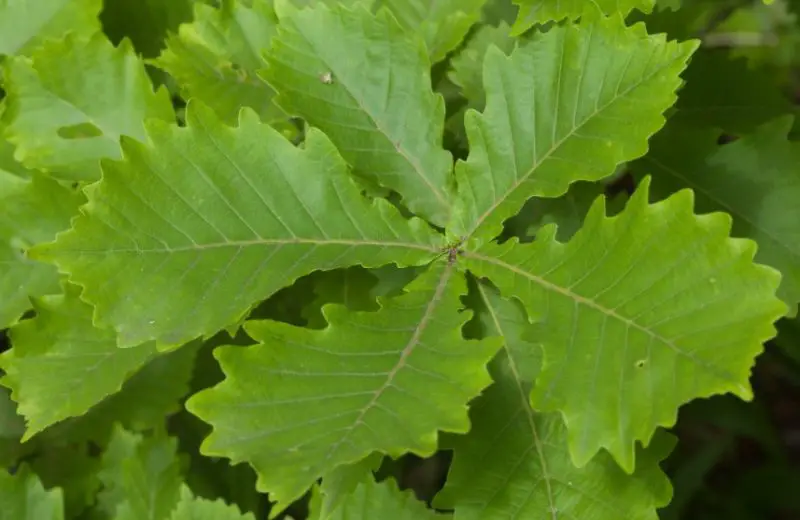
Mongolian Oak is a hardy deciduous tree native to northern Asia, particularly Mongolia, China, and parts of Russia. This species typically grows to a height of 50 to 70 feet and has a broad, rounded canopy. The bark is dark gray, smooth when young but becoming more textured with age. Mongolian Oak is known for its robust growth and ability to withstand cold temperatures, making it ideal for colder climates. It is often found in mixed forests and is a valuable species for timber production.
The leaves of Mongolian Oak are large, with 7 to 9 lobes, and have a dark green color in the summer. They turn golden yellow or brown in the fall before dropping. The acorns of Mongolian Oak are medium-sized, measuring about 1 inch long, with a shallow cup that covers about one-quarter of the nut. These acorns ripen in the fall and provide food for various wildlife species, including birds and small mammals.
Mongolian Oak thrives in USDA hardiness zones 4 through 8, making it suitable for cold climates. It prefers well-drained soils and full sun but can also tolerate partial shade. Once established, it is moderately drought-tolerant. Regular pruning may be necessary to remove dead or diseased branches and to maintain the tree’s shape. Mongolian Oak is an excellent choice for large landscapes or forested areas, providing both ecological and aesthetic benefits.
Chinese Cork Oak (Quercus variabilis)
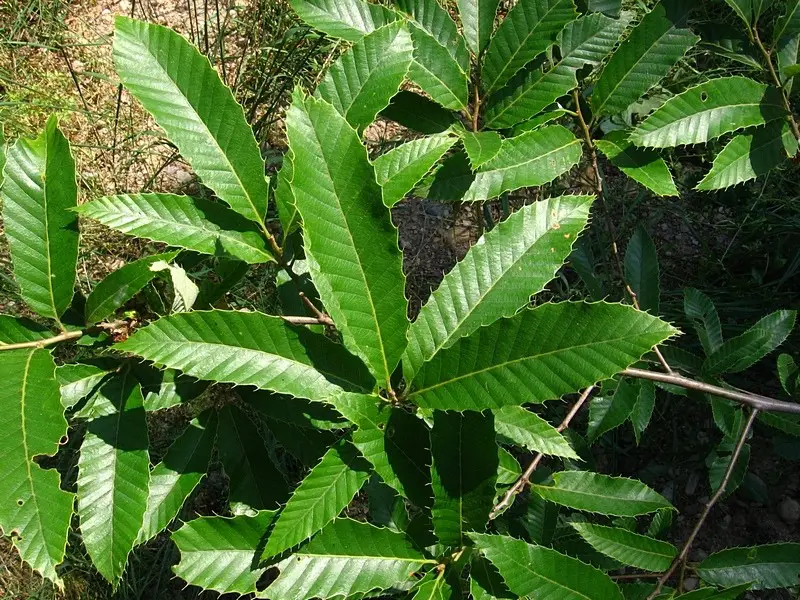
Chinese Cork Oak is a medium-sized deciduous tree native to China and parts of East Asia. It typically reaches a height of 50 to 60 feet and has a rounded, spreading canopy. The bark is thick, cork-like, and deeply ridged, which is characteristic of this species. This oak is prized for its high-quality cork, which has been used for centuries in various industries. The tree has strong, upright branches that spread outward, creating a dense, umbrella-like canopy.
The leaves of Chinese Cork Oak are oval or oblong, with a leathery texture and a glossy dark green color. The margins are usually smooth or slightly wavy, and they turn yellow or brown in the fall. The acorns are medium-sized, about 1 inch long, with a deep, cup-shaped cap. These acorns ripen in autumn and serve as food for wildlife, particularly squirrels and birds.
Chinese Cork Oak grows well in USDA hardiness zones 7 through 9, preferring well-drained, slightly acidic soils. It thrives in full sun but can tolerate partial shade. Once established, it is drought-tolerant and requires minimal maintenance. Pruning may be needed to remove dead or damaged branches. This oak is often used in landscapes for its cork-producing capabilities and ornamental value.
Ring-Cupped Oak (Quercus glauca)

Ring-Cupped Oak is an evergreen tree native to parts of East Asia, including Japan, Korea, and China. It typically grows to a height of 40 to 60 feet and has a dense, pyramidal shape. The bark is smooth and light gray, with a slightly reddish tinge when young, becoming rougher with age. The tree has a compact canopy, making it suitable for smaller landscapes where shade is desired. It is also well-suited for coastal areas due to its resilience in salty environments.
The leaves of Ring-Cupped Oak are elliptical, leathery, and glossy, with a rich green color that persists throughout the year. The leaf edges are smooth or slightly wavy, and the foliage remains attractive even in winter. The acorns are small to medium-sized, about 1 inch in length, with a shallow cup that partially covers the nut. These acorns ripen in late autumn and provide food for various animals, including birds and small mammals.
Ring-Cupped Oak thrives in USDA hardiness zones 7 through 9, preferring well-drained, acidic soils. It grows best in full sun but can tolerate partial shade. Once established, it is moderately drought-tolerant and requires minimal care. This oak species is well-suited for coastal landscapes and urban environments, where it provides year-round interest and is easy to maintain.
Konara Oak (Quercus serrata)

Konara Oak is a medium-sized deciduous tree native to Japan and parts of Korea. It typically reaches heights of 30 to 60 feet and has a rounded, broad canopy that provides dense shade in the summer. The bark of the Konara Oak is light gray or brown and smooth, becoming more textured with age. This oak is commonly found in mountainous and forested regions, where it thrives in nutrient-rich soils. The tree is valued for its ornamental qualities and is often planted in parks and gardens.
The leaves of the Konara Oak are elliptical and sharply pointed, with a smooth or slightly wavy margin. They are deep green during the growing season and turn yellow or reddish-brown in the fall. The acorns of this oak species are small to medium-sized, with a shallow, bowl-shaped cup that only partially covers the nut. These acorns ripen in the fall and provide food for various wildlife species, including birds and small mammals.
Konara Oak thrives in USDA hardiness zones 5 through 8 and prefers well-drained, acidic soils. It requires full sun to partial shade and is moderately drought-tolerant once established. Regular pruning is necessary to maintain the tree’s health and structure. This species is well-suited for ornamental planting in parks, streetscapes, and other landscapes.
Chinese Evergreen Oak (Quercus myrsinifolia)
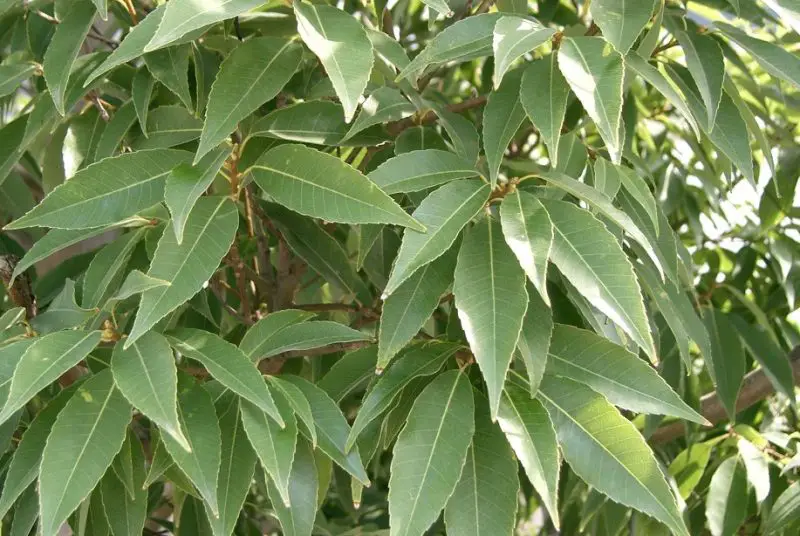
Chinese Evergreen Oak is an evergreen species native to parts of China, Taiwan, and Southeast Asia. This oak can grow up to 60 feet tall, with a dense, rounded canopy. Its bark is smooth and dark gray, becoming rougher as the tree matures. The tree is often found in subtropical and temperate regions, thriving in moist, well-drained soils. Chinese Evergreen Oak is a slow-growing species that can live for many decades, making it a valuable addition to landscapes and forests.
The leaves of Chinese Evergreen Oak are leathery, elongated, and glossy, with a dark green color that remains vibrant year-round. The leaf edges are smooth or slightly wavy, and the tree’s dense canopy provides year-round shade. The acorns of this species are small to medium-sized, about 1 inch long, and have a deep, cup-shaped cap. These acorns ripen in the fall and are an important food source for wildlife, including squirrels, birds, and small mammals.
This species thrives in USDA hardiness zones 7 through 9, preferring well-drained, acidic to neutral soils. Chinese Evergreen Oak is relatively drought-tolerant once established and can tolerate both full sun and partial shade. Minimal care is needed once the tree is established, and pruning may be required to remove any dead or diseased branches. Its evergreen nature makes it an excellent choice for providing year-round structure and interest in landscapes.
Vietnamese Oak (Quercus langbianensis)

Vietnamese Oak is a rare and lesser-known species found in the highlands of Vietnam. This oak typically grows to a height of 30 to 50 feet and has a broad, pyramidal canopy. It is often found in subtropical forest areas, where it thrives in the moist, well-drained soils of the region. The bark of the Vietnamese Oak is smooth and light gray, becoming more textured as the tree matures. It is well-suited to the cooler, highland environments of Vietnam and has become an important species in the country’s forestry industry.
The leaves of Vietnamese Oak are large, elliptical, and glossy, with a deep green color. They turn yellow or reddish in the fall before dropping, though some leaves may remain on the tree for a longer period. The acorns are medium-sized, with a deep cup that covers a large portion of the nut. These acorns mature in the fall and provide food for wildlife in the region, though they are not as commonly seen in other parts of the world due to the tree’s limited range.
Vietnamese Oak is adapted to USDA hardiness zones 8 through 10, thriving in acidic, well-drained soils and partial to full sun. The tree is moderately drought-tolerant once established and is relatively low-maintenance. However, it does require a humid and temperate climate to grow successfully. Due to its rarity and limited geographical range, the Vietnamese Oak is mostly seen in its native habitat or specialized botanical gardens.
Taiwan Oak (Quercus tarokoensis)
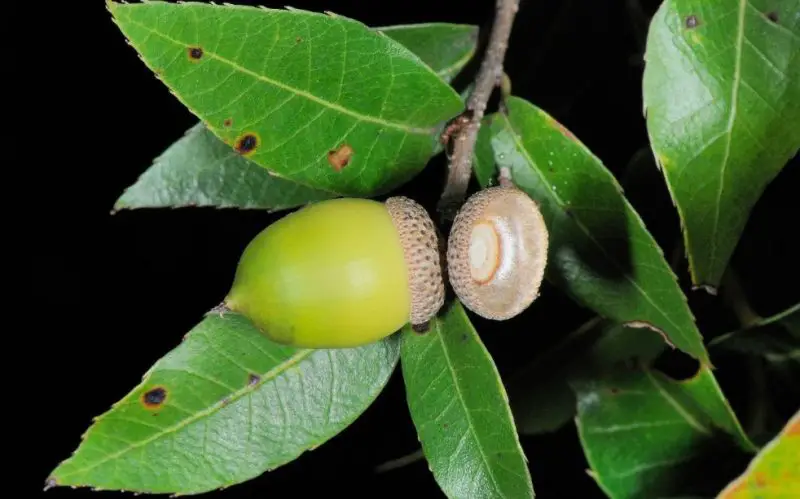
Taiwan Oak is a unique oak species native to the central mountainous regions of Taiwan. It is a medium-sized deciduous tree that can reach heights of 40 to 60 feet, with a broad, rounded canopy that provides ample shade. The bark of Taiwan Oak is grayish-brown and smooth when young, becoming more textured with age. This species is commonly found in the higher elevations of Taiwan, where it thrives in the cool, temperate climate of the island’s mountains.
The leaves of Taiwan Oak are oblong and leathery, with a deep green color that becomes a golden yellow or reddish-brown in the fall. The leaf edges are often smooth or slightly wavy, adding to the tree’s aesthetic appeal. The acorns of Taiwan Oak are relatively small, about 1 inch long, with a shallow, cup-shaped cap. These acorns ripen in the fall and serve as food for various forms of wildlife, including birds and small mammals native to Taiwan.
Taiwan Oak grows best in USDA hardiness zones 7 through 9 and prefers slightly acidic, well-drained soils. It thrives in full sun to partial shade and is moderately drought-tolerant once established. This oak species is well-suited for mountainous regions and temperate climates. While it requires minimal maintenance once established, it does benefit from regular pruning to maintain its structure and health. Taiwan Oak is an excellent choice for mountainous or highland landscapes, offering both ecological and ornamental value.
Hybrids and Rare Oaks
Bebb Oak (Quercus × bebbiana)
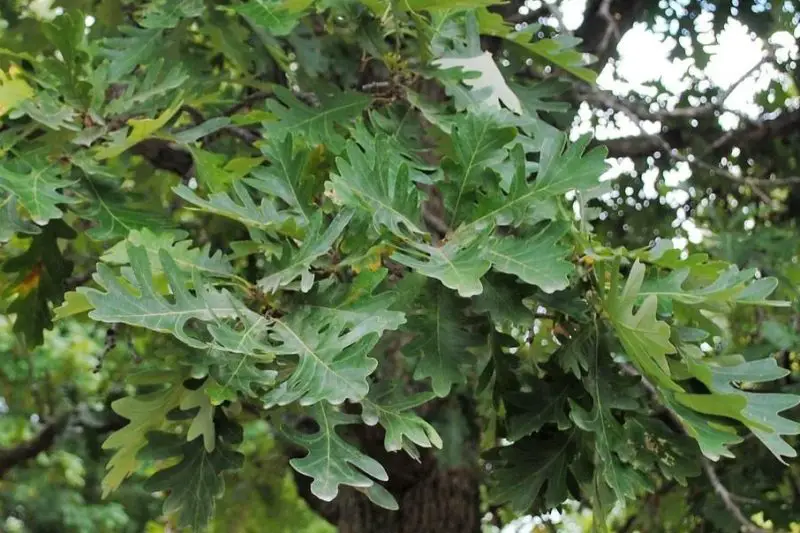
Bebb Oak is a hybrid tree resulting from the cross between Bur Oak and White Oak. It typically grows to heights of 50 to 70 feet, with a wide canopy that provides excellent shade. The bark of Bebb Oak is dark gray and rough, showing typical characteristics of both parent species. This oak is usually found in mixed woodlands and forest edges, thriving in regions with moist, well-drained soils. It is commonly found in the central and eastern United States, where it adapts to a range of soil conditions and climates.
The leaves of Bebb Oak are deeply lobed, with a characteristic shape that reflects its hybrid origin. The leaves are glossy dark green in the summer, turning yellow or reddish-brown in the fall. The acorns of Bebb Oak are medium-sized, about 1 to 1.5 inches long, with a cap that covers about one-third of the nut. These acorns are important food sources for wildlife, including squirrels and birds, especially in the fall when they are fully ripe.
Bebb Oak thrives in USDA hardiness zones 4 through 8, preferring rich, moist soils and full sun to partial shade. It is moderately drought-tolerant once established and is an excellent choice for landscaping in areas with varied soil conditions. This hybrid oak benefits from minimal care and can tolerate both acidic and neutral soils, making it adaptable to many environments.
Lea’s Oak (Quercus × leana)

Lea’s Oak is a hybrid species between Black Oak and Pin Oak, characterized by its robust growth and unique appearance. It can grow to a height of 50 to 60 feet and has a broad, rounded canopy. The bark of Lea’s Oak is dark brown to gray, with a rough texture that is common in both of its parent species. This hybrid is typically found in woodland areas and mixed forests, especially in regions of the central and eastern United States, where it thrives in moist, well-drained soils.
The leaves of Lea’s Oak are large and deeply lobed, with a dark green color during the growing season. They turn a vibrant red or yellow in the fall, providing striking autumn foliage. The acorns of this species are medium-sized, with a cap that covers about one-third of the nut. These acorns are a vital food source for various wildlife, including deer and squirrels, and they ripen in the fall, offering nourishment throughout the colder months.
Lea’s Oak grows best in USDA hardiness zones 4 through 8 and prefers slightly acidic to neutral soils. It is adaptable to both full sun and partial shade, making it suitable for various landscape settings. The tree is moderately drought-tolerant once established and requires little maintenance once planted. Its hybrid nature makes it a hardy and resilient tree for a variety of climates, with minimal care required beyond regular pruning.
Warei Oak (Quercus × warei)

Warei Oak is a hybrid tree created by crossing the English Oak and Bur Oak. This oak reaches heights of 40 to 70 feet and has a broad, upright canopy. The bark of Warei Oak is grayish-brown and rough, with deep fissures that develop as the tree matures. It is often found in mixed woodlands and can tolerate a variety of soil types, making it suitable for many areas across North America. This oak is valued for its ability to thrive in diverse environments, from lowland forests to upland areas.
The leaves of Warei Oak are medium-sized, with a lobed shape that is a blend of the characteristics of both parent species. They are dark green and leathery, turning yellow to reddish-brown in the fall. The acorns of Warei Oak are larger than those of many other oaks, measuring up to 2 inches in length. These acorns are prized by wildlife, particularly squirrels and birds, and they mature in the fall.
Warei Oak thrives in USDA hardiness zones 5 through 8 and prefers well-drained, acidic to neutral soils. It requires full sun or partial shade for optimal growth. The tree is moderately drought-tolerant once established and does well in a variety of climates, from temperate regions to more arid zones. Warei Oak is low-maintenance and requires minimal care, making it a great choice for landscaping and forestry purposes.
Deam Oak (Quercus × deamii)

Deam Oak is a hybrid oak resulting from the cross between Chinkapin Oak and Bur Oak. This medium-sized tree grows to a height of 40 to 60 feet and has a rounded, spreading canopy. The bark is light gray to brown and develops deep fissures with age. Deam Oak is typically found in the central and eastern United States, especially in areas with moist, well-drained soils. It is well-suited to mixed forests and can be found in both upland and lowland regions.
The leaves of Deam Oak are elongated and finely serrated, with a deep green color that turns yellow or orange in the fall. The acorns are small to medium-sized, with a shallow, cup-shaped cap that covers about one-quarter of the nut. These acorns ripen in the fall, providing food for squirrels, birds, and other wildlife that depend on acorns during the colder months.
Deam Oak thrives in USDA hardiness zones 4 through 8 and is adaptable to a variety of soil types, including slightly acidic to neutral soils. It requires full sun to partial shade and is moderately drought-tolerant once established. This hybrid oak species requires minimal care and is an excellent choice for planting in landscapes and forested areas, where it offers ecological benefits and aesthetic value.
Heterophylla Oak (Quercus × heterophylla)

Heterophylla Oak is a hybrid species that results from the cross between Red Oak and Willow Oak. This large tree can grow up to 70 feet tall, with a broad, spreading canopy. The bark is grayish-brown, smooth when young, and becoming rougher as the tree matures. Heterophylla Oak is commonly found in woodlands and forested areas, particularly in the southeastern United States, where it thrives in moist, well-drained soils.
The leaves of Heterophylla Oak are unique, with an elongated shape that resembles those of the Willow Oak, while still retaining the serrated edges typical of Red Oak. The leaves are bright green and turn yellow to reddish-brown in the fall. The acorns of Heterophylla Oak are medium-sized, about 1 to 1.5 inches long, with a shallow cap. These acorns ripen in the fall and are an important food source for various wildlife, including birds and small mammals.
Heterophylla Oak thrives in USDA hardiness zones 5 through 9 and prefers acidic, well-drained soils. It requires full sun to partial shade for optimal growth and is moderately drought-tolerant once established. This hybrid oak species requires little maintenance and can be planted in a variety of landscapes, where it provides both ecological and ornamental value.
Escarpment Live Oak (Quercus fusiformis)

Escarpment Live Oak, also known as Texas Hill Country Live Oak, is a slow-growing evergreen oak native to the rugged terrains of central and western Texas. This tree typically reaches a height of 20 to 30 feet, with a wide, sprawling canopy that provides ample shade. The bark is dark gray and smooth when young, becoming more deeply fissured as the tree matures. It thrives in rocky hillsides, steep slopes, and other challenging landscapes, making it well-suited to the harsh conditions of its native region.
The leaves of Escarpment Live Oak are leathery and evergreen, with a glossy dark green appearance that lasts throughout the year. The leaves are small to medium-sized and oval, with rounded edges. During the fall and winter months, the tree produces small acorns that are an important food source for wildlife, including squirrels and deer. These acorns are typically 1 inch long and have a shallow cap.
This oak species is well-adapted to USDA hardiness zones 7 through 9 and is drought-tolerant once established, making it ideal for xeriscaping and dry, rocky environments. It prefers well-drained soils and full sun but can tolerate some partial shade. Escarpment Live Oak is low-maintenance, requiring minimal care once established, and it is valued for its resilience and ability to thrive in Texas’ hot, dry climate.
Arkansas Oak (Quercus arkansana)
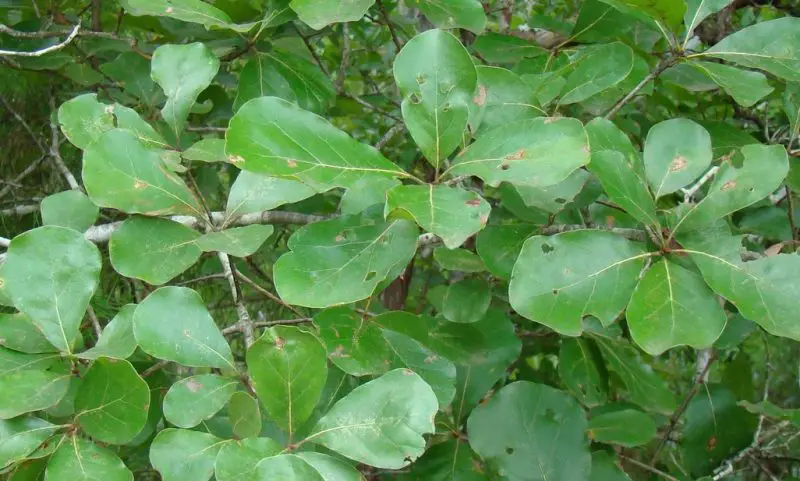
Arkansas Oak is a relatively rare species found in the southeastern United States, primarily in Arkansas, Missouri, and surrounding regions. This medium-sized tree typically reaches heights of 30 to 50 feet, with a rounded, open canopy. The bark of Arkansas Oak is light gray-brown and develops deep ridges as it matures. It grows in a variety of soil types but is particularly found in dry upland forests, particularly on acidic, well-drained soils.
The leaves of Arkansas Oak are deeply lobed, resembling those of other red oak species. They are dark green during the growing season and turn yellow, orange, or red in the fall, offering a striking display of autumn color. The acorns are small to medium in size, about 1 inch long, with a shallow cup that covers roughly one-third of the nut. These acorns provide food for wildlife, including squirrels and birds.
Arkansas Oak thrives in USDA hardiness zones 5 through 8 and is adaptable to a range of soil conditions, including slightly acidic soils. It prefers full sun to partial shade and is moderately drought-tolerant once established. Although rare in the wild, Arkansas Oak is a great option for landscaping in areas where it can grow in well-drained soils and provide shade and wildlife benefits.
Hinckley Oak (Quercus hinckleyi)
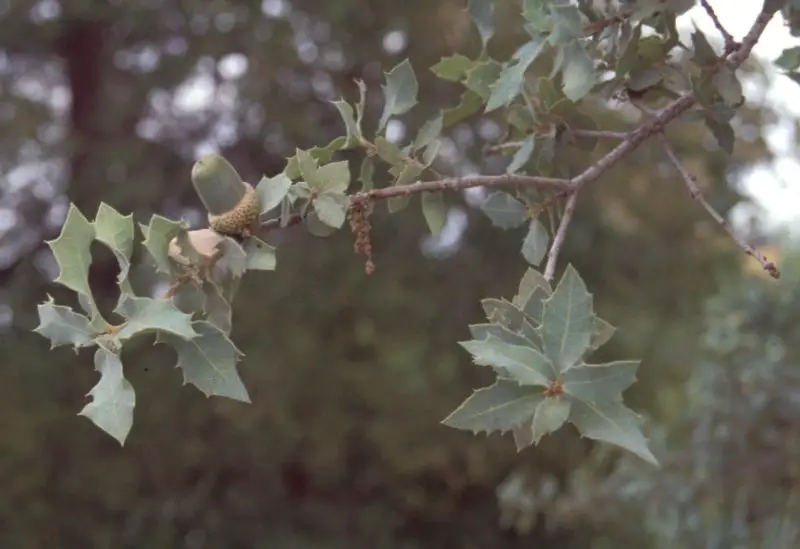
Hinckley Oak is a critically endangered species native to the desert regions of central and west Texas. It is a small, slow-growing tree, typically reaching a height of 15 to 20 feet. The bark is grayish-brown and smooth, with a somewhat gnarled appearance due to its harsh growing conditions. Hinckley Oak thrives in arid, rocky hillsides and is often found in isolated pockets where it can survive the dry conditions of its native environment.
The leaves of Hinckley Oak are small, dark green, and leathery, with a slightly fuzzy texture on the underside. The tree produces small acorns that are an important food source for desert wildlife, including rodents and birds. These acorns are typically about 1 inch in length, with a shallow cup and a slightly rounded shape.
Hinckley Oak thrives in USDA hardiness zones 7b to 9, where it requires minimal water and thrives in dry, rocky soils. It is an excellent choice for xeriscaping and areas with low water availability. Due to its critically endangered status, it is important to plant and care for Hinckley Oak with attention to conservation practices, ensuring it remains a part of its native desert ecosystem.
Toumey Oak (Quercus toumeyi)
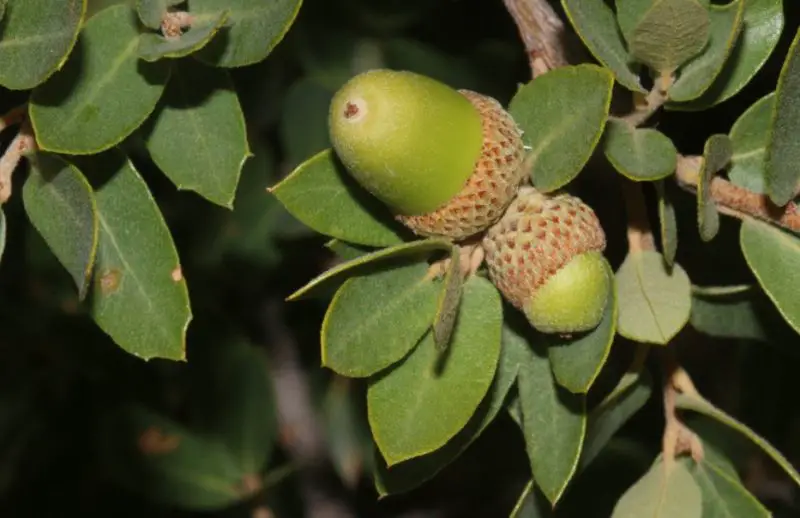
Toumey Oak, also known as the southwestern oak, is native to the southwestern United States and northern Mexico. This tree can grow to 30 to 40 feet in height and features a rounded canopy with a relatively narrow spread. The bark is light gray-brown with deep fissures, characteristic of the oak species in the southwestern U.S. Toumey Oak thrives in the dry, rocky soils of the region, often found at higher elevations in mountainous areas.
The leaves of Toumey Oak are dark green, leathery, and often have a slightly glossy appearance. They are typically elliptical or oblong in shape, with a smooth margin or slight lobing. The acorns of this oak species are medium-sized, with a cap that covers approximately one-quarter to one-half of the nut. These acorns are an important food source for wildlife, especially in the fall when they ripen.
Toumey Oak is well-suited to USDA hardiness zones 7 through 9, where it thrives in dry, well-drained soils. It is drought-tolerant once established and prefers full sun. Its ability to thrive in harsh conditions and its unique aesthetic qualities make it a good choice for xeriscaping and other landscaping projects in the southwestern U.S. and northern Mexico.
Vasey Oak (Quercus vaseyana)
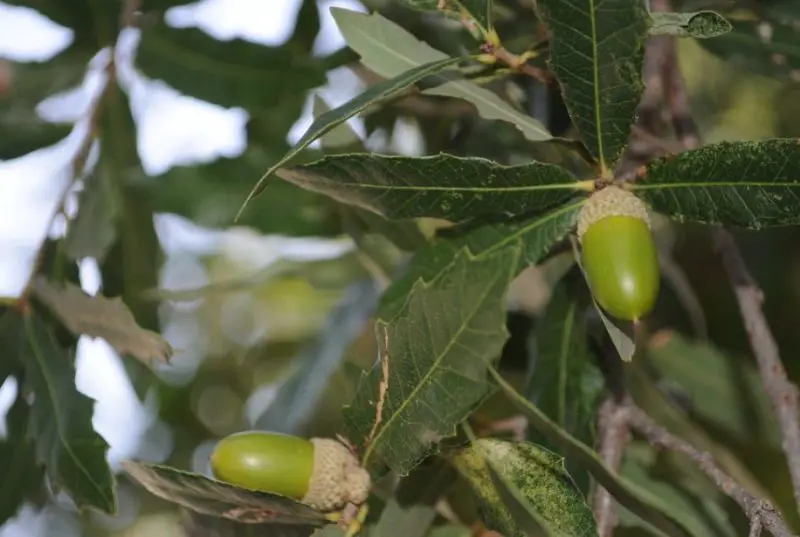
Vasey Oak is a species native to Texas and northern Mexico, often found in dry, rocky regions of the southwestern United States. This oak species typically grows to heights of 25 to 40 feet, with a rounded, dense canopy. The bark is grayish-brown with a rough texture and deep furrows as the tree matures. Vasey Oak is adapted to the challenging conditions of the Texas Hill Country, where it thrives in nutrient-poor, rocky soils.
The leaves of Vasey Oak are smaller than those of many other oak species, with a leathery texture and deep green color during the growing season. They turn yellow or reddish-brown in the fall, offering a beautiful display of autumn color. The acorns of Vasey Oak are small, about 1 inch in length, and are an important food source for various wildlife, including birds, squirrels, and deer. These acorns are typically covered by a shallow cap.
Vasey Oak is well-suited to USDA hardiness zones 7b through 9, where it can withstand dry conditions and thrive in full sun. It is drought-tolerant once established and requires little maintenance. This oak is often used in landscaping and reforestation projects in arid regions, providing shade and habitat for wildlife in Texas and northern Mexico.


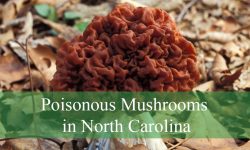




Thank you for providing such detailed descriptions of a wide variety of oak trees along with great photos of the leaves and acorns. I was especially interested in your description of the “Bur Oak.” The city in Oregon where I own property has this insane desire to dramatically increase the tree canopy in town. They have planted a number of trees in the public right-of-way (between the city sidewalk and the street) that easily outgrow the small spaces where they are placed. Over time, their invasive root systems cause considerable damage to the sidewalks and often damage water meters and private property – walkways, foundations, etc. Recently, the city planted a Bur Oak in a similar area adjacent to my property. I knew the species because the nursery tag had been left on the tree. Knowing the tree species, I suspected it was an example of this municipality making their usual stupid decision in tree choices. Your thorough description of this species left no doubt in my mind. I’m not adverse to the “tree canopy” concept. However, I strongly object to a government entity making decisions over and over again that defy logic. If I’m to assume that the tree canopy objective is meant to reduce the carbon footprint, but the city is constantly grinding sidewalks and tearing out and replacing others because of damage caused by tree roots, does that make sense? In fact, I would argue that the carbon footprint in this city has actually grown due to this nonsense. There are tree species that are quite suitable for the areas I described – and clearly others that are not.